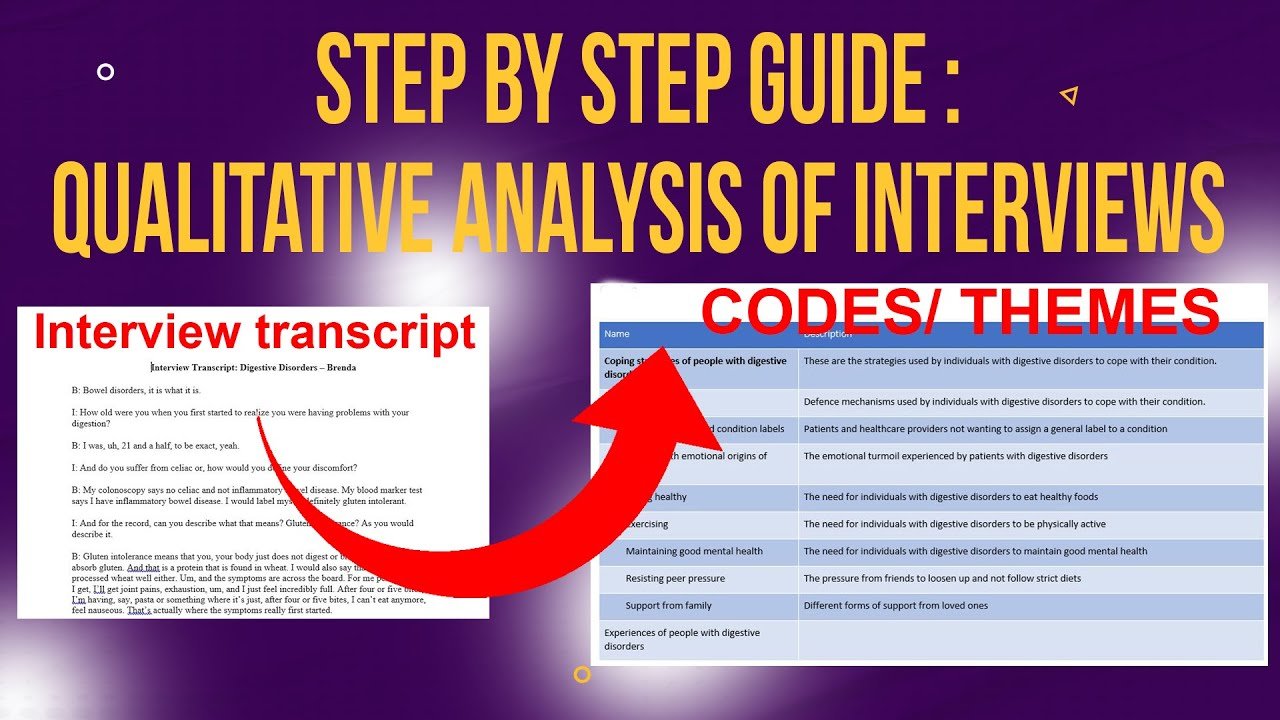Thematic Analysis Examples: Inductive And Deductive (Step by Step Guide)
In this article, I will teach you how to do thematic analysis of interviews.
This article will look at the two main approaches to doing thematic analysis, which are the inductive and the deductive approaches to thematic analysis
This is an in-depth article that will go step by step from understanding the philosophical basis of thematic analysis.
The article will also highlight which studies are ideal for thematic analysis and also describe the types of thematic analysis.
Research Philosophies
Let’s understand the philosophical basis of thematic analysis.
Generally, there are three main research philosophies that operate on different ontological and epistemological assumptions.
The research philosophies include positivism, interpretivism, and pragmatism
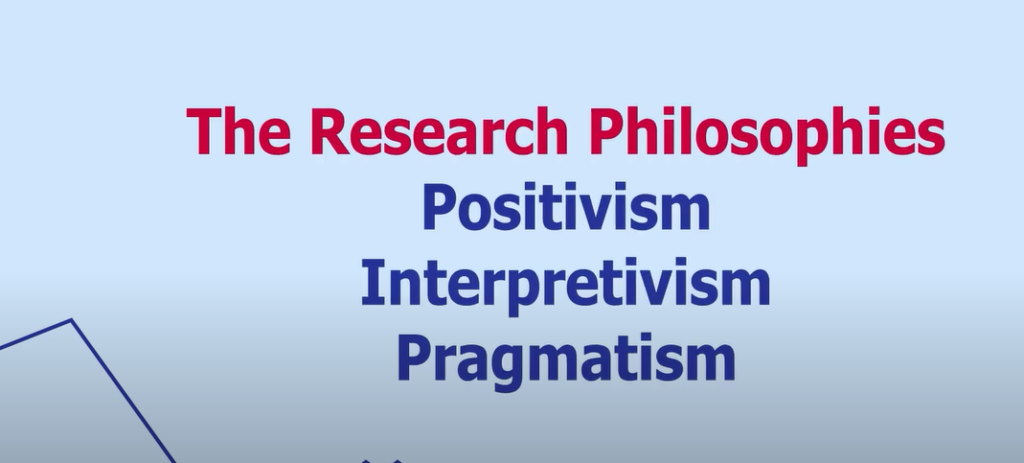
The Three Research Philosophies
Now, let’s understand what ontology and epistemology are before we explore the different research philosophies.
Ontology basically deals with the nature of reality of what we can know.
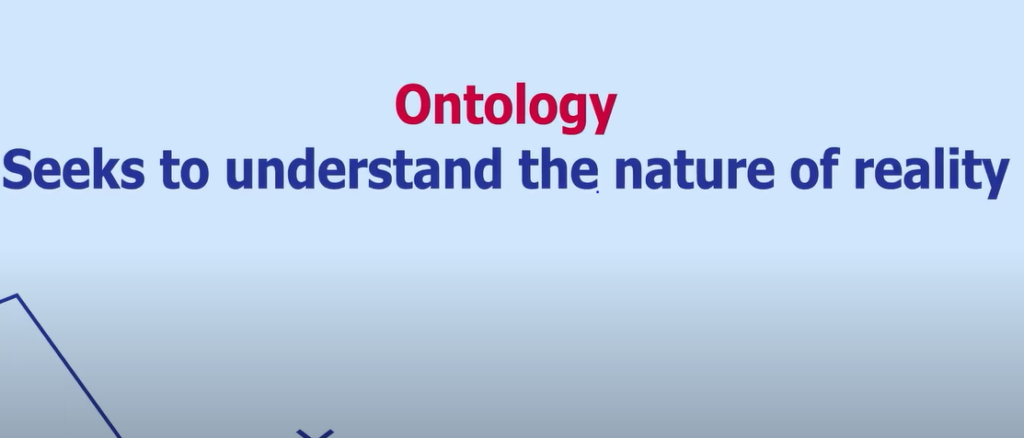
Image Defining Ontology
For example, is a given experience objective or subjective to each individual?
Subjective experiences will be different to every individual, while objective experiences are the same for all individuals.
For instance, you might want to investigate if individuals who attended a football match had different or similar experiences.
Such an investigation is based on ontology as we seek to understand the nature of reality.
On the other hand, epistemology relates to how we can obtain knowledge and understand different phenomena.
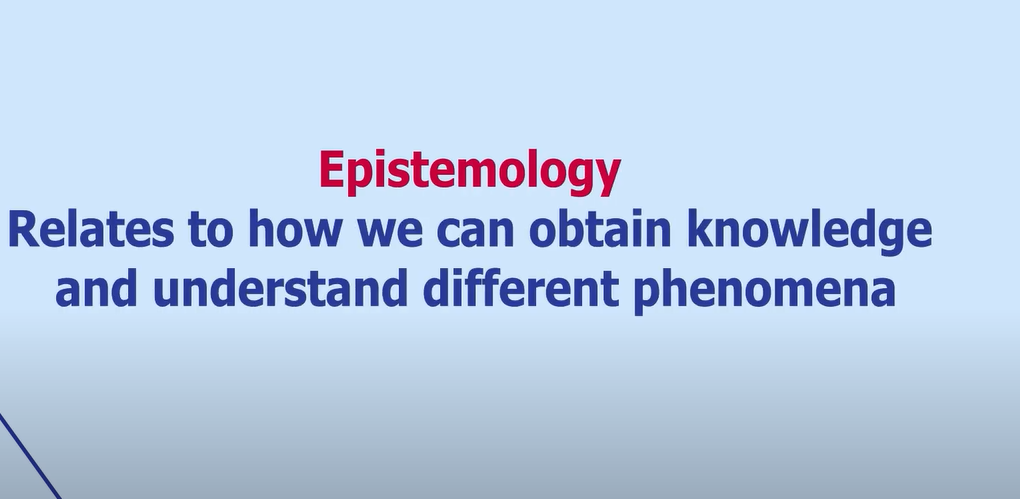
Image Describing Epistemology
Epistemology will therefore deal with how we can figure out given phenomena and the limit of our knowledge.
In this regard, through epistemology, we get evidence in order to rationally make certain conclusions.
An example of how epistemology can help distinguish between coincidence and reliable knowledge is someone who believes it will rain tomorrow because they dreamt of it.
Even though they don’t understand metrology, if it does rain, their belief is true, but it wasn’t justified without evidence or without specific rationality.
Now let’s go back to research philosophies to see how both ontology and epistemology play within these philosophies and how we look at nature and our world.
Positivism
Let’s start with positivism.
The positivist research philosophy is based on the premise that knowledge can only be gained from neutral and measurable observations of actions.
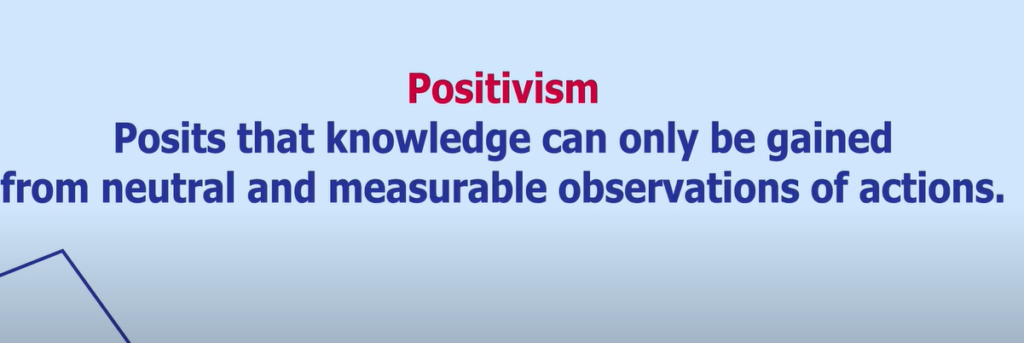
Image Describing Positivism
Researchers who use the positivist research philosophy hold that, if something is not measurable, it cannot be known for certain.
In the positivist research philosophy, anything that cannot be observed, then measured, and quantified is of no importance.
In positivist research philosophy, knowledge is either classified as either being true, false, or meaningless.
In this research philosophy, other ways of knowing such as introspection, intuition, and religious faith are considered meaningless or rejected altogether.
In this regard, the positivist research philosophy is in direct opposition to the philosophies we adopt in qualitative research.
The positivist research philosophy is therefore mainly applied in quantitative research, such as when conducting experiments.
For example, a study to determine the prevalence of a given condition in a given population adopts a positivist philosophy.
Interpretivism
Now, let’s look at another research philosophy, Interpretivism.
On the opposite edge of the spectrum of research philosophies is Interpretivism.
This research philosophy is based on the premise that reality is socially constructed and subjective.
The interpretivism research philosophy posits that multiple realities can in fact exist and occur.
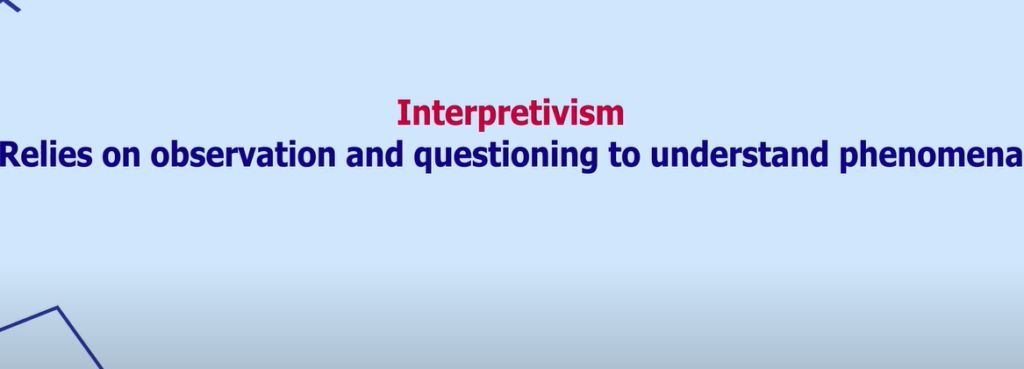
Image describing interpretivism
Now, relying on the interpretivism, research philosophy, we can only understand research subjects’ reality through their experiences of that reality, which is subjective and will differ from one person to another based on social or historical perspectives.
Interpretive approaches to research will rely on observation and questioning in order to generate and discover a rich and deep understanding of specific phenomenon being investigated.
For example, a researcher seeking to understand the impact of trauma on a given population that has undergone traumatic events may adopt an interpretative philosophy.
Pragmatism
Now, let’s look at another philosophy of research, which is pragmatism.
Although positivist and interpretative approach are in direct contrast to one another, the pragmatic research philosophy highlights that there are different ways of interpreting the world after a researcher has conducted research to investigate reality.
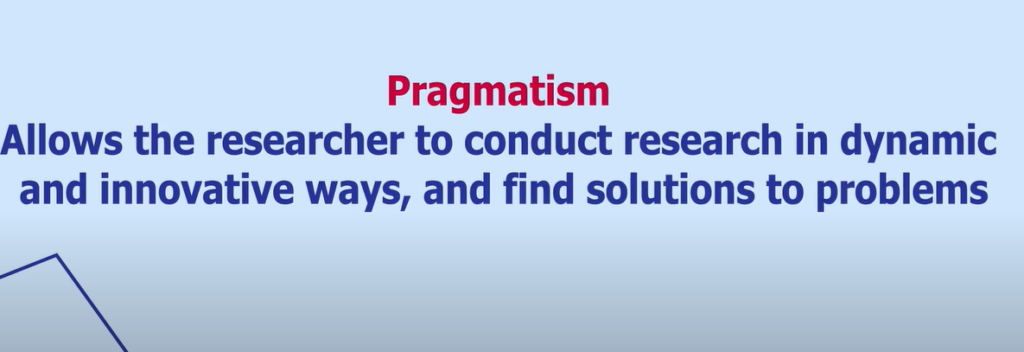
Image Describing Pragmatism
In this regard, combining different approaches may provide a broad understanding of phenomena that are being investigated.
So, the pragmatic approach to research is guided by what will work in the given context, and finding the best answers to questions under investigation.
The pragmatic approach to research, therefore will allow a researcher to conduct research in dynamic and innovative ways, and to find solutions to problems.
Pragmatic studies therefore investigate the different factors that might influence individual actions in given situations.
However, the main characteristic of pragmatism as a research philosophy is that pragmatists will acknowledge that their research inquiry will not lead to certainty.
A pragmatic approach to research, therefore does not assume there is one final truth and avoids, fixed principles or abstract generalizations.
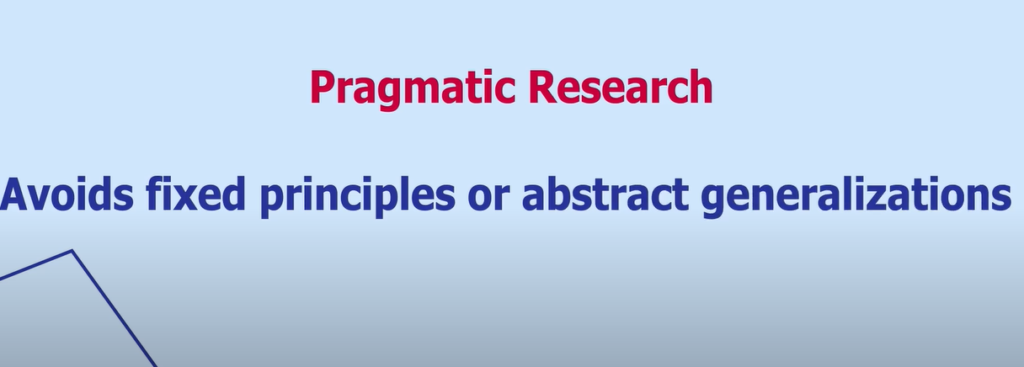
Image Describing Pragmatism
Now, let’s tie what we have learned up.
Having clearly defined the three main research philosophies, including positivism, interpretivism, and pragmatism, it’s evident that when we are conducting qualitative studies and we want to use thematic analysis in our research, The philosophy we will use is either interpretivism or pragmatism
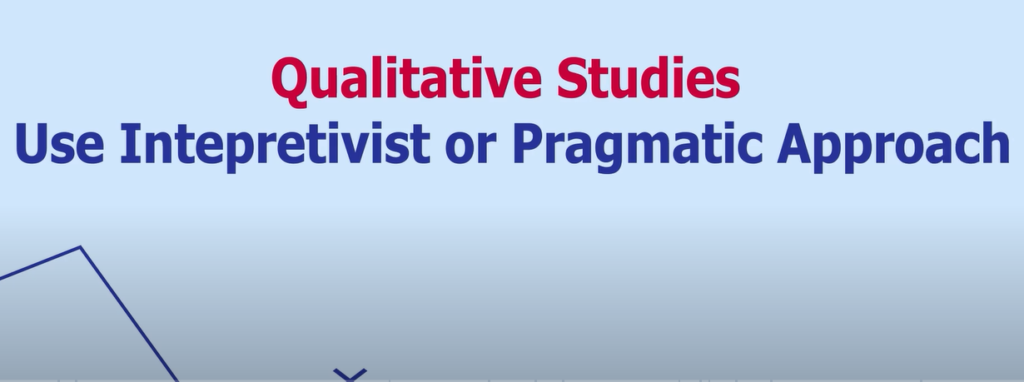
Image of Studies Ideal for Interpretivist and Pragmatic Approach
Personally, I prefer the pragmatic approach because it’s more flexible and more suited to thematic analysis approaches such as the Braun and Clark six step framework for thematic analysis.
With this in mind, it means that we cannot make definitive statements about our results as one would find if they were conducting a quantitative study.
So, those conducting quantitative studies only rely on the positivist research philosophy,
Now, when conducting qualitative studies and when applying interpretivist research philosophy, we therefore always leave a room for different interpretations of given phenomena.
Studies Ideal for Thematic Analysis
Now, let’s look at which studies are ideal for thematic analysis.
Generally, thematic analysis is an ideal approach to analyze qualitative data when one is trying to find out about:
- People’s views
- Opinions
- Experiences
- Assessing people’s knowledge about a given topic
- Assessing people’s values or beliefs
- Exploring questions about how people interpret their experiences and the meanings they attach to them.
Now, what are the types of thematic analysis?
Types of Thematic Analysis
The two main approaches to thematic analysis are the inductive and deductive thematic analysis
Inductive Thematic Analysis
Let’s understand first, what is inductive thematic analysis.
The inductive approach to thematic analysis involves deriving deems from qualitative data without any preconceptions.
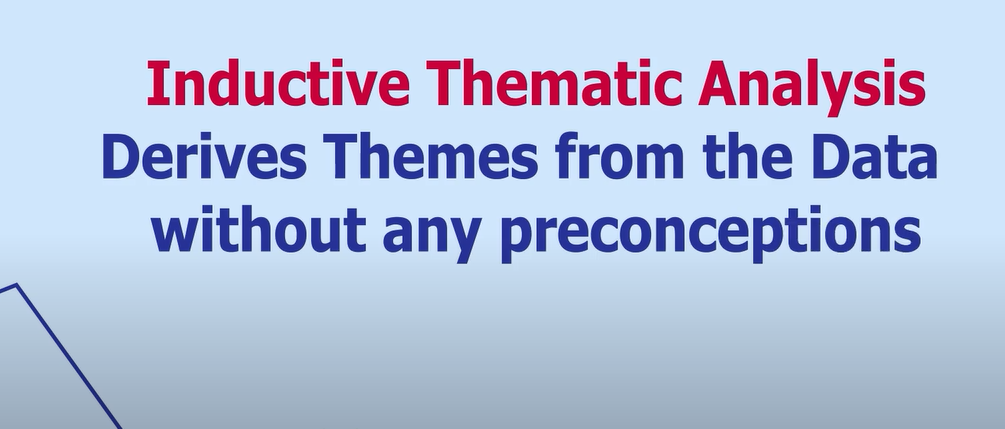
Image Defining Inductive Thematic Analysis
That means that we dive into the qualitative data, such as interview transcripts and formulate codes, subthemes and themes from what the data provides.
For example, let’s say you are investigating the feelings of people after getting fired.
You would investigate the themes that emerge from the interviews with such participants, without any preconceived ideas of what you might find out.
This would be an inductive approach to thematic analysis.
An example of an inductive approach to thematic analysis is the Brown and Clark six step framework for thematic analysis.
Now, we are going to conduct inductive thematic analysis through this Brown and Clark six step framework for conducting thematic analysis.
The steps of the Braun and Clarke framework include:
- Familiarizing yourself with the transcripts
- Generating initial codes
- Coming up with themes
- Reviewing and refining themes
- Providing clear descriptions of the themes
- Writing the findings report.
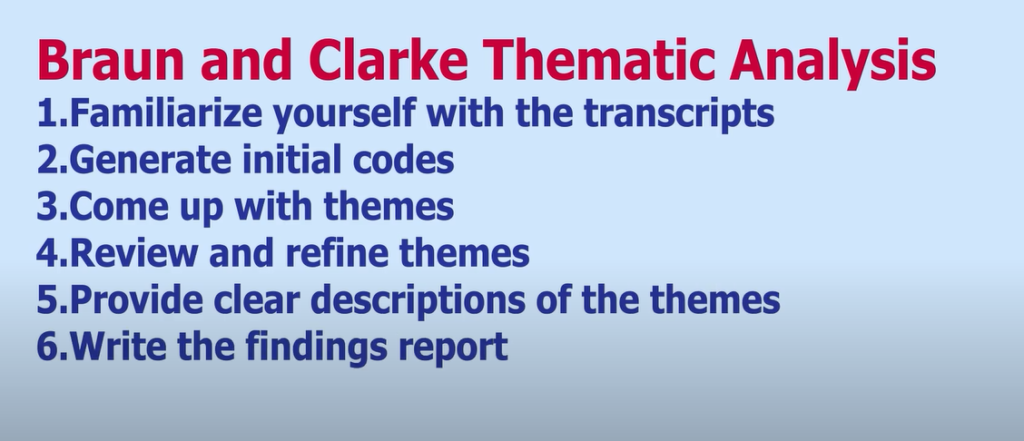
Image of the Braun and Clarke Six Step Framework
For this example, we are going to go through a study titled: Teacher’s Challenges in Executing Alternatives to Corporate Punishment in Secondary Public Schools.

Image of a Study Title
I want to show you where I get the transcripts and the studies, I use is in a website called Figshare.

A Screenshot of Figshare( Figshare is a Website where You can Access Qualitative Interviews)
Maybe you might want to practice qualitative analysis before you go and do your real work. You can go to figshare. com and look for transcripts.
These are students who share their transcripts. And they share it with everybody, So, check out figshare.
Back to my study title.
For this example of inductive thematic analysis, I’m trying to analyze transcripts based on the study title: Teachers Challenges in Executing Alternatives to Corporal Punishment in Secondary Public Schools.

Image showing a Study Title
The research objectives are:
- To determine whether teachers support abolition of corporal punishment in enforcing discipline in their schools.
- To evaluate the types and sources of discipline problems common in school.
- To explore the alternatives to corporal punishment measures applied in school.
- To determine the type of rewards teachers, give to deserving learners and whether those rewards encourage them to be disciplined.
- To determine whether disciplinary measures teachers take to discipline learners have been able to address the issue of indiscipline or disruptive behaviour in their school. 6. To evaluate the teacher’s perception of the role of parents and other stakeholders in maintaining discipline in the school.
Those are a lot of objectives, but I want you to note down the objectives and to understand that the objectives have a significant role to play in analyzing qualitative data because we only code data that contributes to our research questions or research objectives.
We don’t code any data that does not relate to our research objectives.
Now, as you can see, I have two transcripts that I’m going to use for this article to give you an example of how to code inductively.

The Two Transcripts for Analysis
Familiarizing with the Transcripts
The first step is familiarizing with the transcripts.

Image of Familiarizing with the Transcripts
I’m going to go through the transcripts, and read through them like a story, with no preconceived ideas of what I want to do or the analysis.
Just read through all of them, okay?
Ill go through the two transcripts to get an idea of what the researcher is trying to find out.
That’s the first step is familiarizing with the transcripts.
Generating Initial Codes
Then I move to the second step, which is generating initial codes.

Image of Generating Initial Codes
In this step, I normally use a computer aided qualitative data analysis software or CAQDAS.
For example, I use Nvivo 14.
Let’s open Nvivo.
When I’m doing inductive Qualitative analysis, even deductive. I use this software to manage everything that I might have.
The first thing you’re going to see when you open Nvivo. is this area where we have new project and this blue menu on my left.
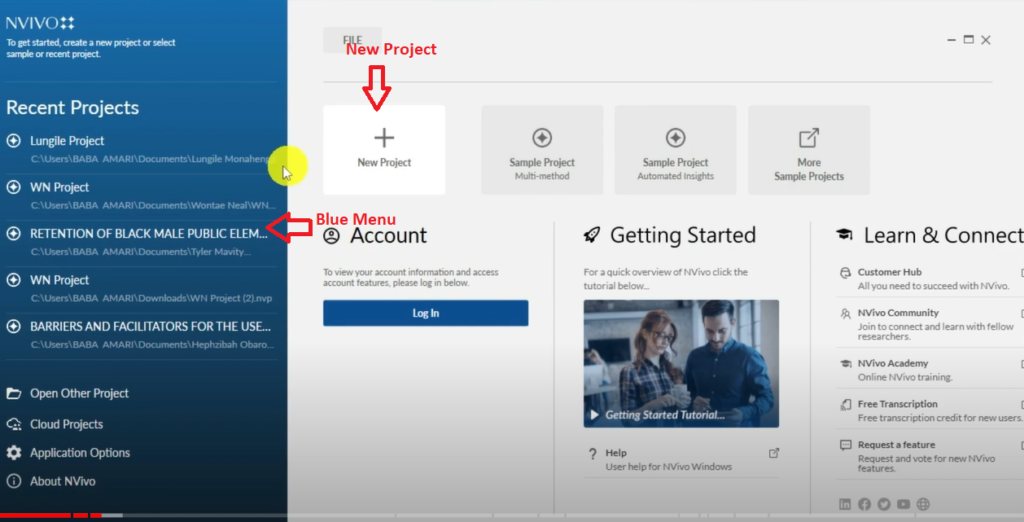
Nvivo 14 Screenshot
Let’s call this CP sample CP means corporate punishment. Just let me name it like that.
So, CP sample and we can see, then I click on Next.
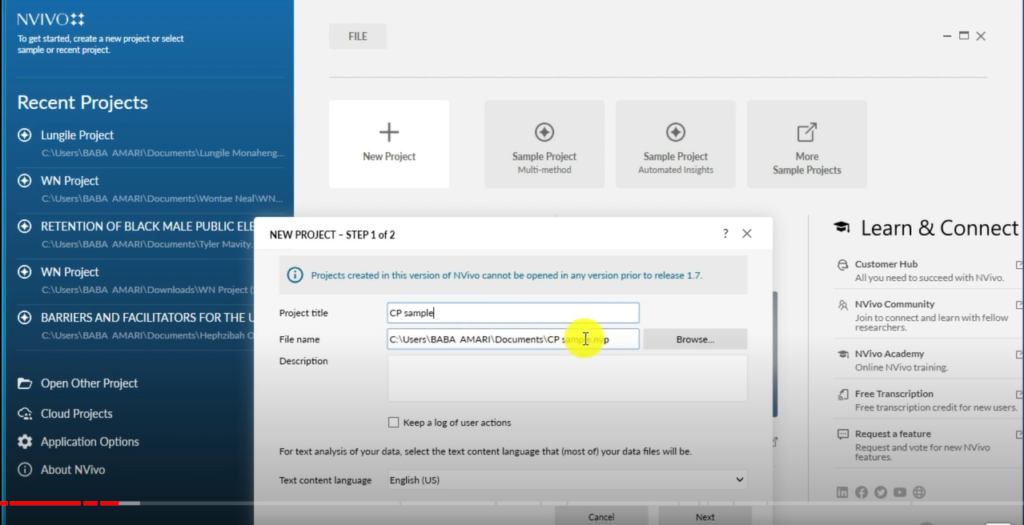
The project Cp Sample is Created
I want you to be careful. When using Nvivo, when you click on Next, don’t allow Nvivo to ever autosave your project. Cause you might lose your data.
Let me remind you, just go to Display Save Reminder and You put in, put some minutes, you can put or change this to 10.
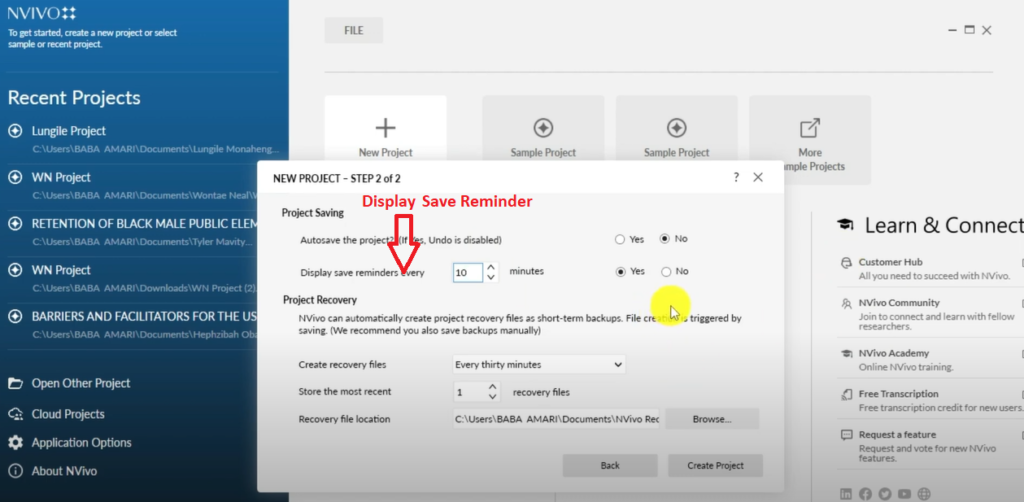
Display Save Reminder in Nvivo 14
So every 10 minutes Nvivo is going to give us a reminder to save our work.
That means we never have to lose any data, even if Nvivo crashes, which happens many times.
Remember, we are in the second step of conducting inductive thematic analysis, which is generating initial codes.
So, here we have opened Nvivo.
You can see Nvivo has two main menus. The blue one and the top one.
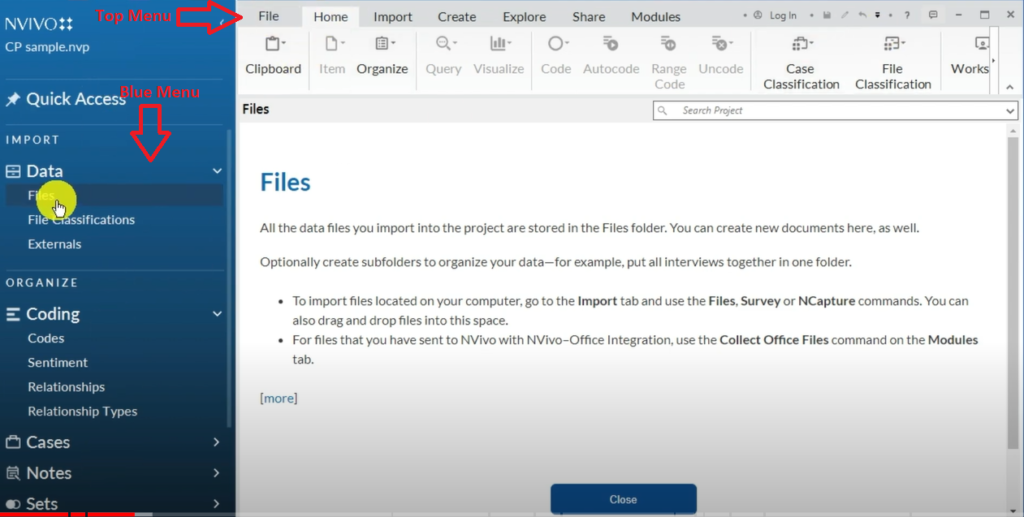
The Blue Menu and The Top Menu in Nvivo 14
As a beginner, just focus on files and codes. Files, codes. Don’t worry about all the other functionalities.

The Files Section and The Codes Section in Nvivo 14
We import the files in the files section.
There are two ways of importing our transcripts into Nvivo.
First is by dragging and dropping files in the files section.
The second way is easy. Go to import, go to files, find the folder, and click import.

The Import Button in Nvivo 14
I have my two files.
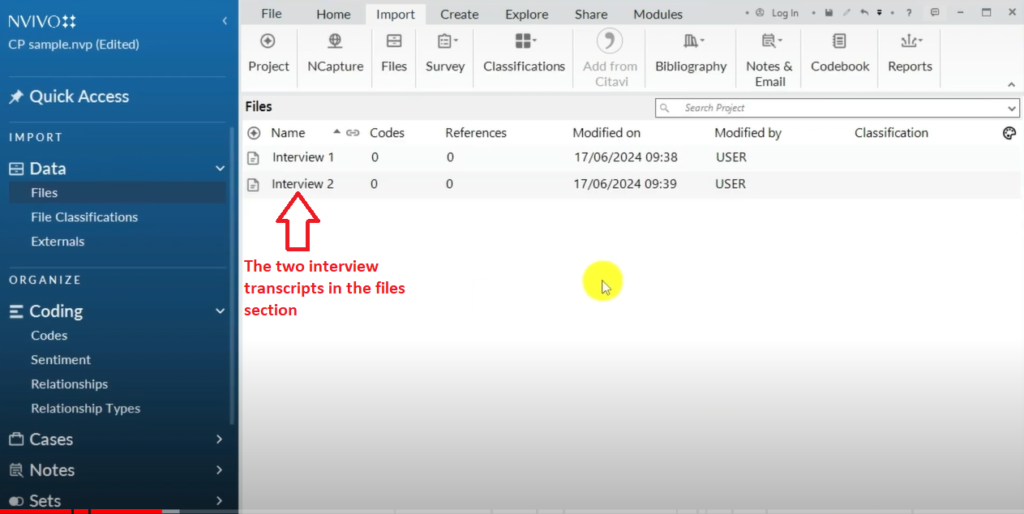
The Interview Transcripts in Nvivo 14
So let me begin coding.
Now, the first thing we have to understand when we are coding, if I may just repeat, is we only code information that’s important to our research questions.
We do not code information that’s not relevant to our research topic, research questions, or research objectives.
That’s how we determine what to code and what not to code.
Now, what are codes? Codes are interpretative or shorthand labels to information that’s important to our research questions or objectives.
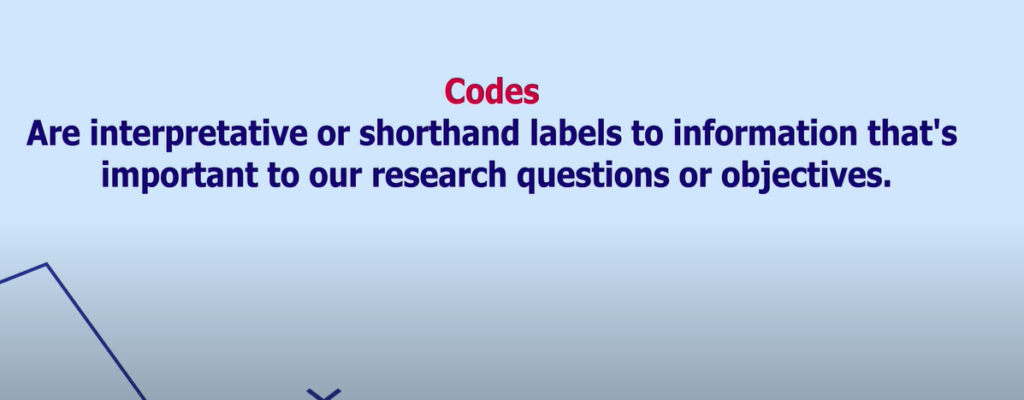
Codes Definition
With that definition of codes, I can begin coding.
Remember, the title of the study is Teacher’s Challenges in Executing Alternatives to Call for Punishment in Secondary Public Schools.
With that study title in mind, let me go to the code section of Nvivo.

The Codes Section in Nvivo 14
We are going to create codes in the codes section.
I’m going to drag and drop the codes in the codes section.
Let’s go to the first transcript.
This is an interview that a certain teacher conducted among other teachers, to collect their views related to the abolition of corporal punishment in secondary schools.
Let’s go.
“Do you support the abolition of corporal punishment in enforcing discipline in your school? Give reasons for your answers.“
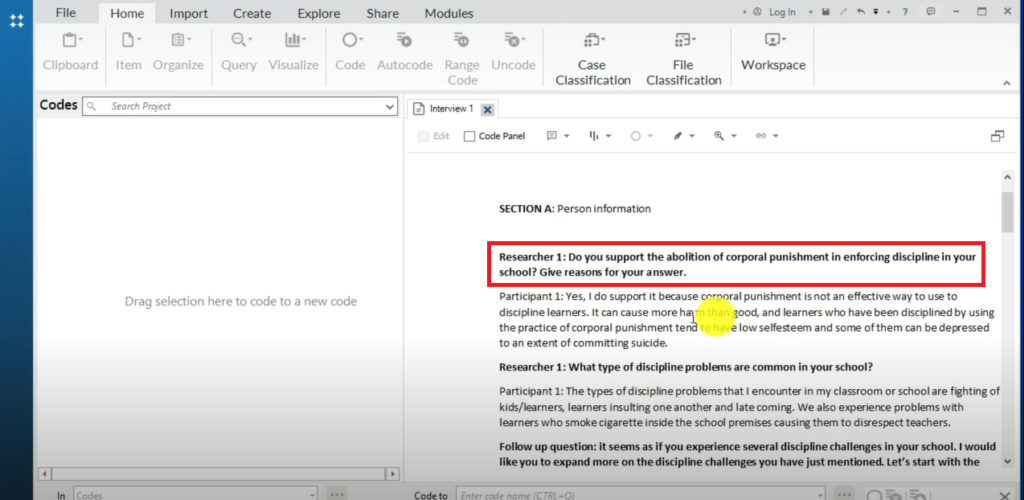
A Section of Transcript 1 in Nvivo 14
I will create codes related to this question.
Remember, we are doing inductive thematic analysis. That means we do not have a predetermined set of codes or themes that we are going to find in the data.
We are creating the codes and then we are looking for a pattern of shared meaning between the codes to develop the themes.
But we’ll get to that. Let’s get back to generating initial codes.
So, “do you support the abolition of corporal punishment in enforcing discipline in your school? Give reasons for your answers.“
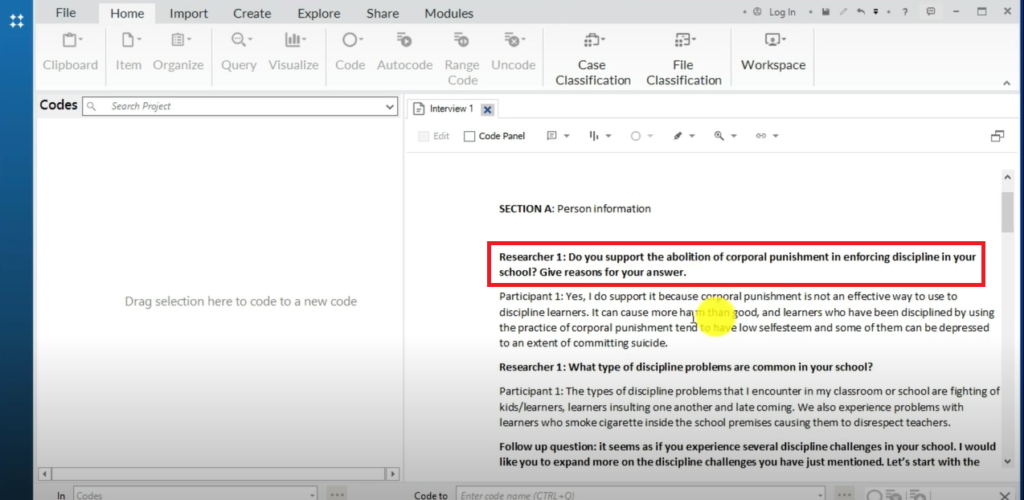
A Section of Transcript 1 in Nvivo 14
You can see participant one. “Yes , I do support because corporal punishment is not an effective way to use to discipline learners.“
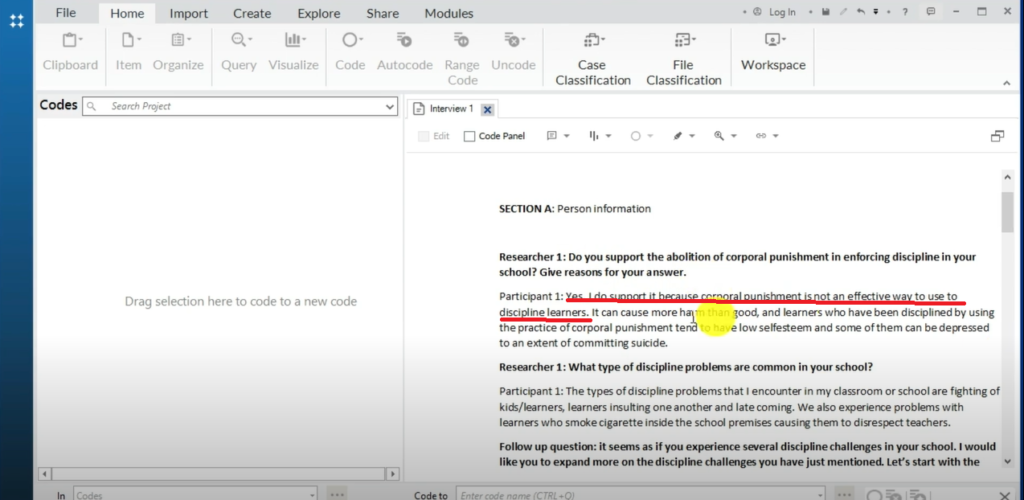
A Section of Transcript 1 in Nvivo 14
This person is saying corporal punishment is ineffective
I can highlight this area and drag and drop to the codes section and say corporal punishment is ineffective in disciplining students.

The Code Corporal Punishment is Ineffective in Disciplining Students is Created
Codes can be short or long, but they need to be as concise as naturally possible.
If I go back to the interview transcripts let’s generate another code related to the first sub question that was asked by the interviewee.
“It can cause more harm than good, and learners who have been disciplined by using the practice of corporal punishment. tend to have low self esteem and some can be depressed to an extent of commuting suicide.”

A Section of Transcript 1 in Nvivo 14
So, we code this as corporal punishment can harm students.
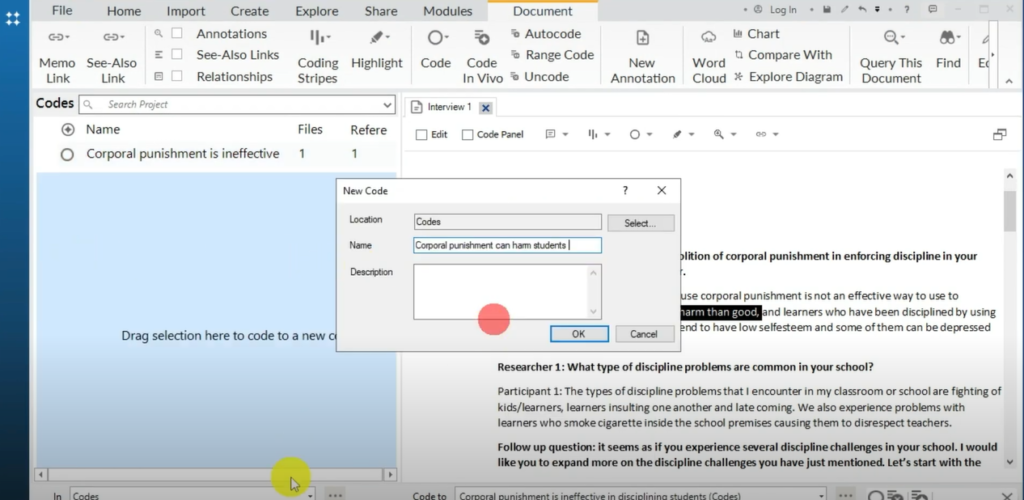
The Code Corporal Punishment can Harm Students is Created
Remember, my codes are a bit descriptive, coding is a very subjective process.
You have to decide which is the most ideal code for this statement, so this is just a sample.
Basically, we need to understand the statements that the interviewees are providing so that we can tag them with the right codes.
“And learners who have been disciplined by using the practice of corporal punishment tend to have low self esteem.“

A Section of Transcript 1 in Nvivo 14
I can code this statement as; corporal punishment contributes to low self esteem.
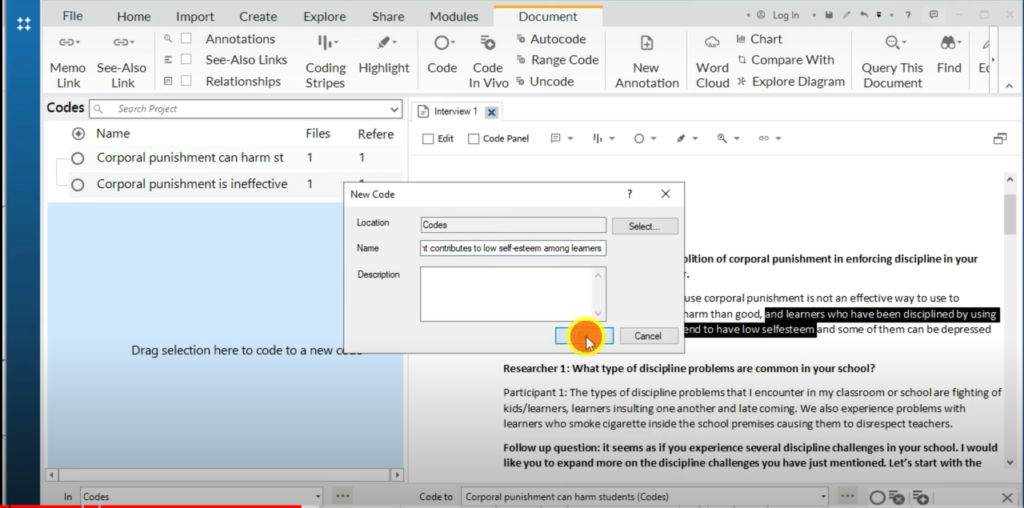
The Code Corporal Punishment Contributes to Low Self- esteem among Learners is Created
Corporal punishment contributes to low self esteem among learners. That’s another code
Then, “and some of them can be depressed to an extent of committing suicide.“
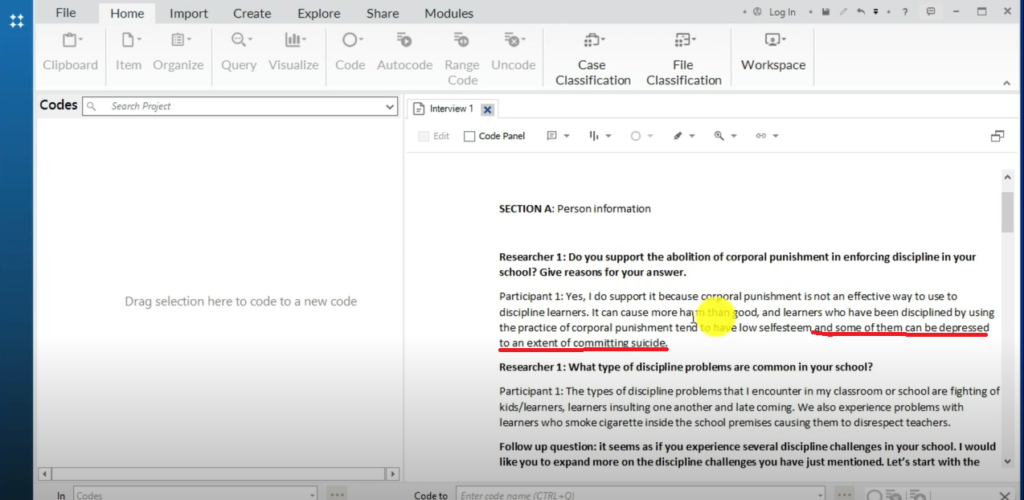
A Section of Transcript 1
Let me call that corporal punishment can lead to depression
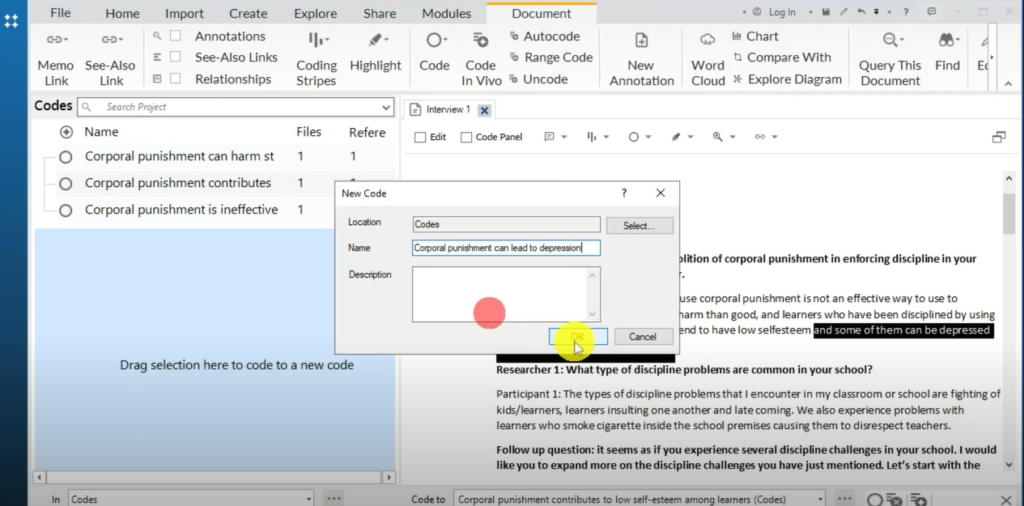
The Code Corporal Punishment can Lead to Depression is Created
Let’s do another sub question
I’m on question two.
“What type of discipline problems are common in your school.”

A Section of Transcript 1
“The types of discipline problems that I encounter in my classroom or school are fighting of kids stroke learners.”

A Section of Transcript 1
We code this as fighting.
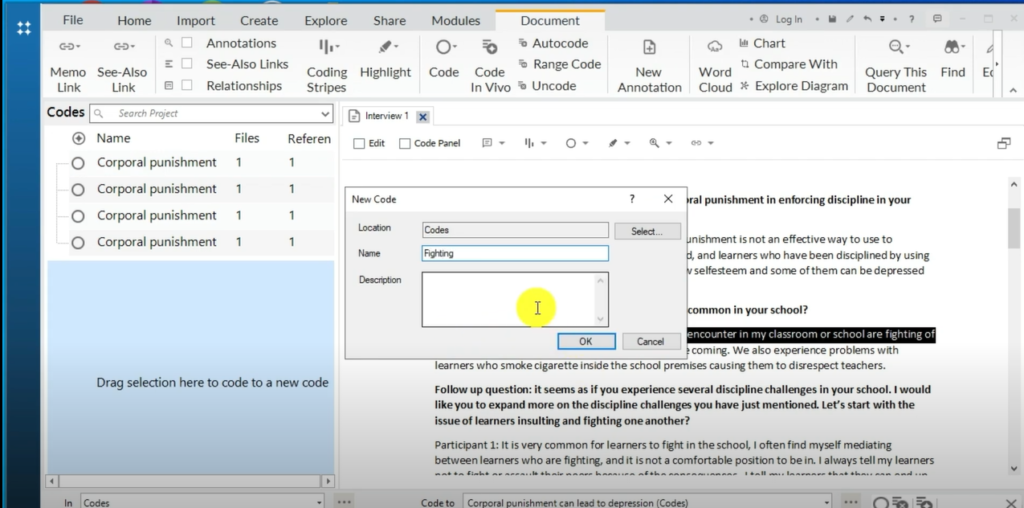
The Code Fighting is Created
Let’s keep coding.
“Learners insulting one another.“
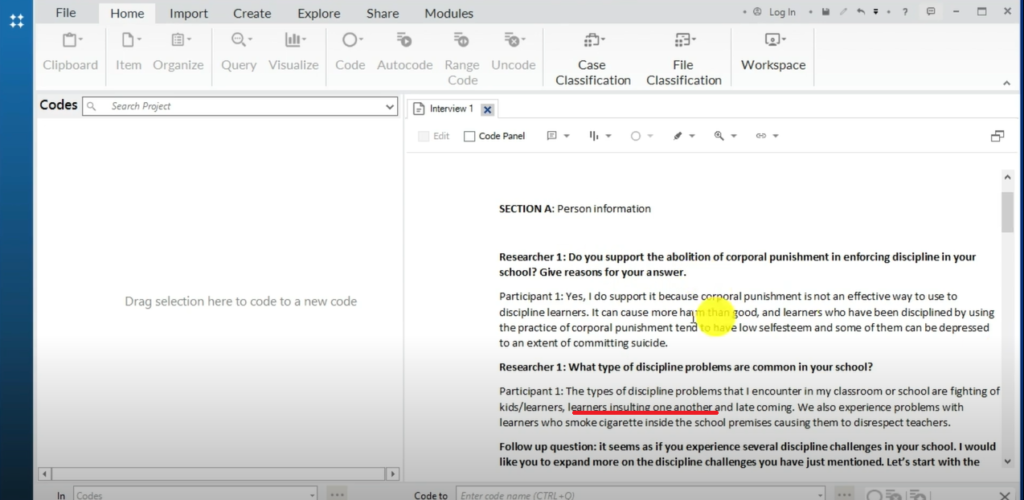
A Section of Transcript 1
That’s a kind of indiscipline. So let me code that as learners insulting one another.
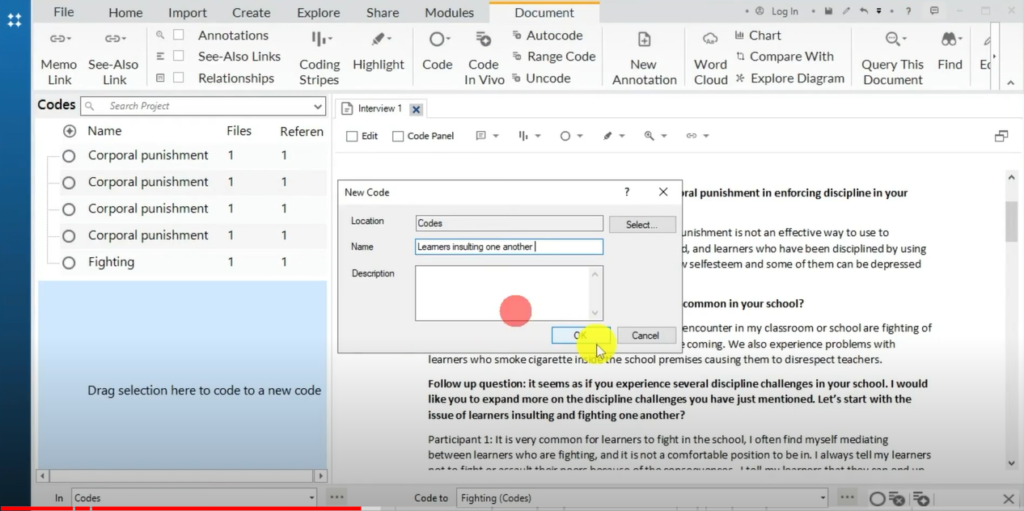
The Code Learners Insulting One Another is Created
Okay. And late coming.
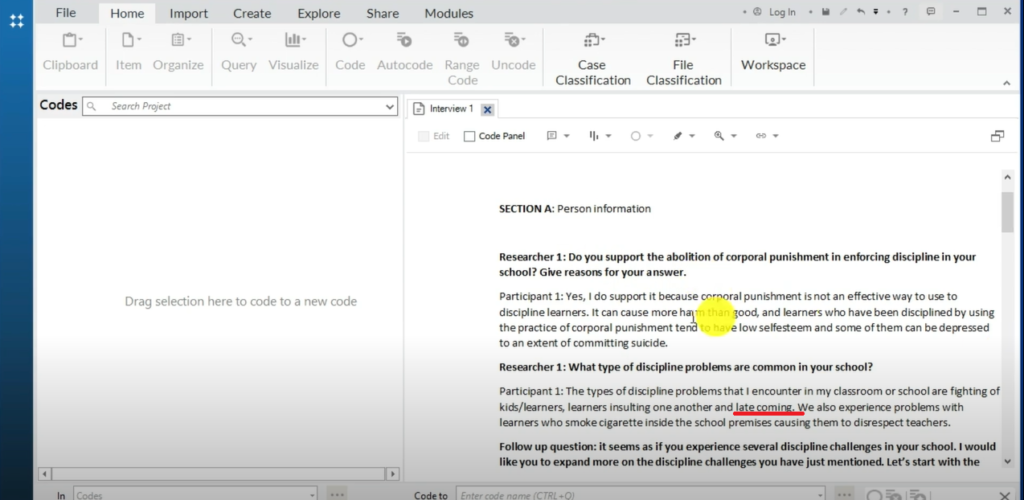
A Section of Transcript 1
So, we code that as late coming.
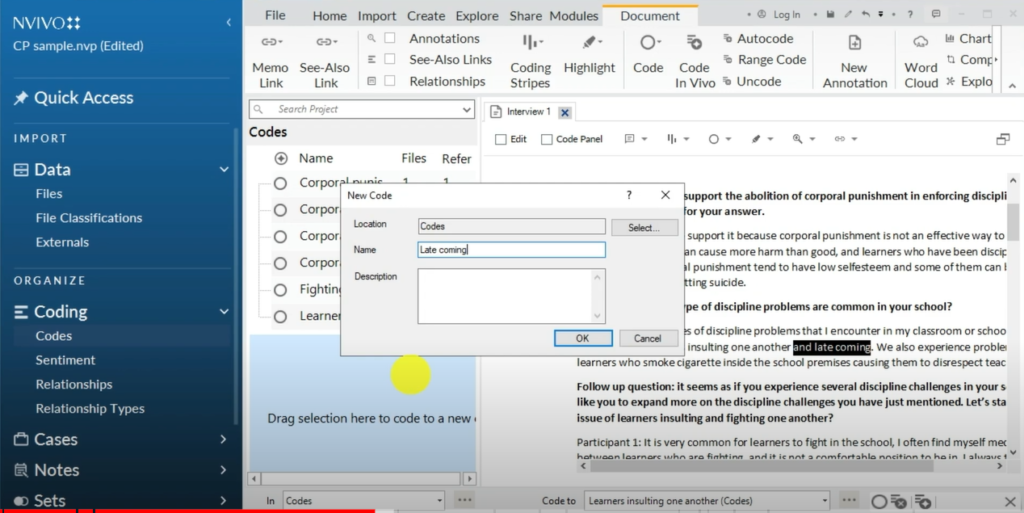
T he Code Late Coming is Created
That’s how we generate initial codes in NVivo.
Now, after generating initial codes from the two transcripts, I’m going to have as many codes as you can see here.

Codes Generated from the Two Transcripts
Generating Initial Themes
Now let’s move to the third step of the Brown and Clark six step framework for thematic analysis, which is generating initial themes.
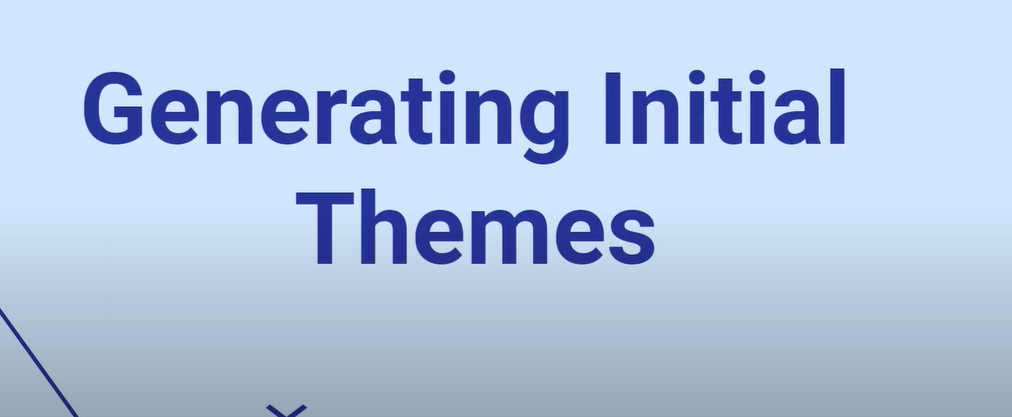
Generating Initial Themes
Now, I want to look at these four codes in red and then consider the question which the interviewer asked.
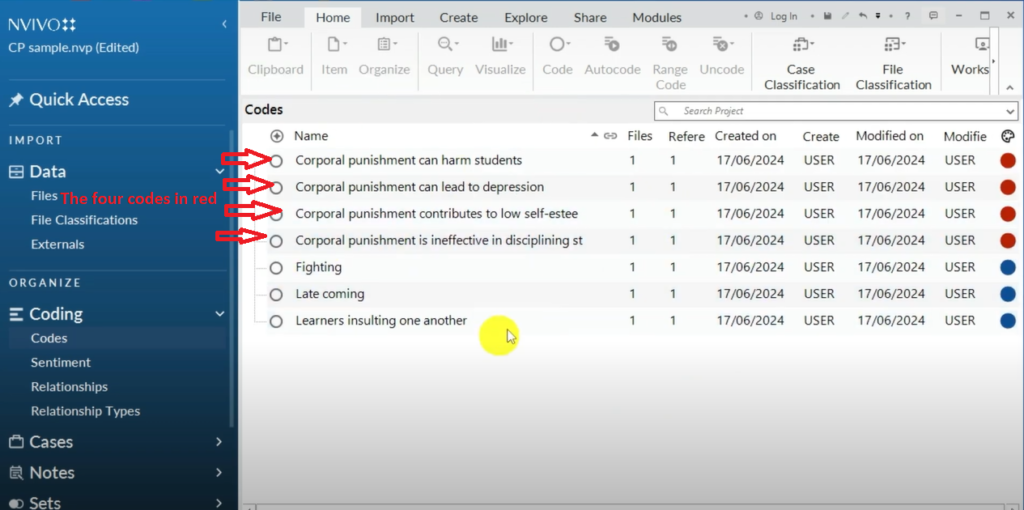
Four Colour Coded Codes in Nvivo 14
Do you support abolition of corporal punishment in enforcing discipline in school? Give your reasons.
These codes in red are related. Okay, look at these four codes. If you read the codes you’ll notice, they are talking about, teacher’s Support of Abolition Corporal Punishment.
So we create a theme title Teacher’s Support of Abolition of Corporal Punishment.
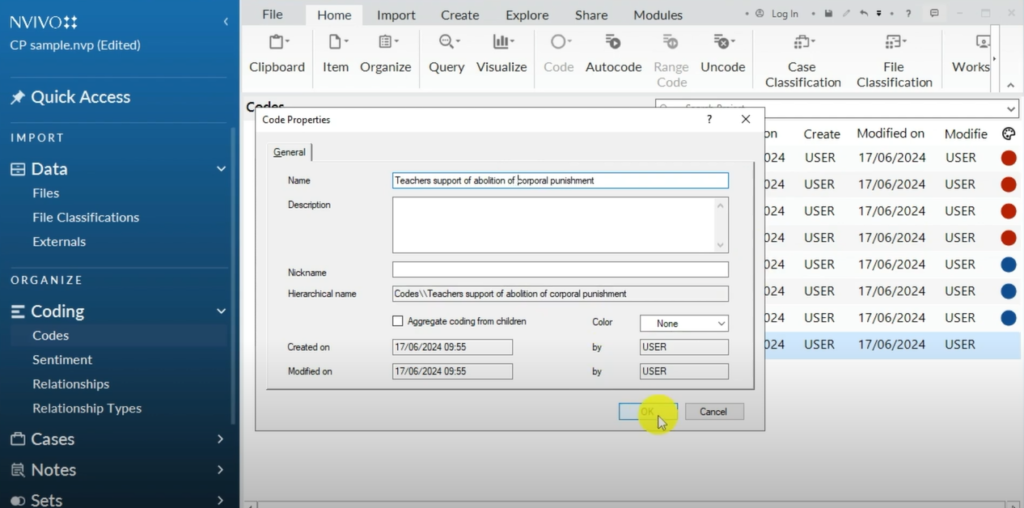
The Theme Teachers Support of Abolition of Corporal Punishment is Created
So that’s a theme now.
I want to show you why it’s a theme, Because if you look at the shared pattern of meaning of these codes
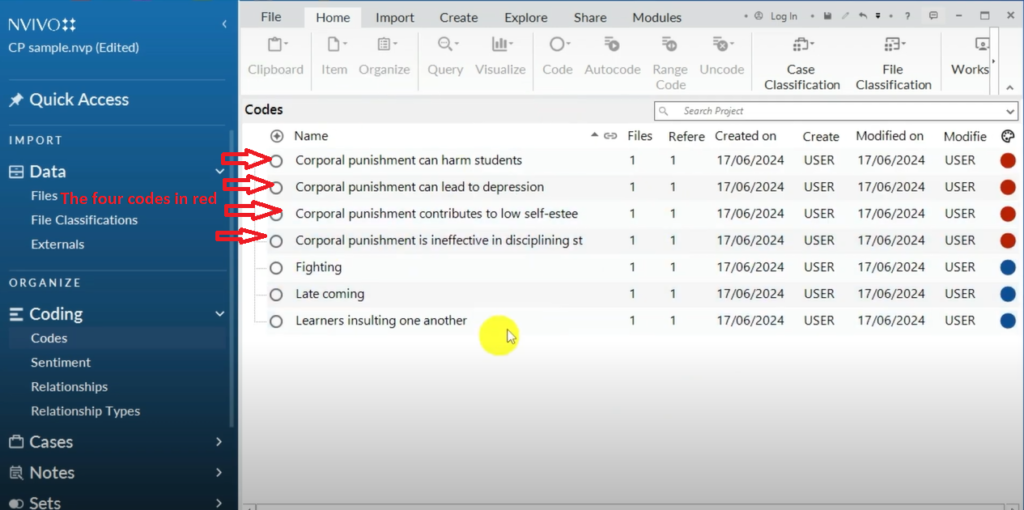
The Codes Colour Coded Red
Also inspired by the question that was posed by the interviewer, I can drag and drop the codes in red into the theme Teacher support of abolition of corporal punishment
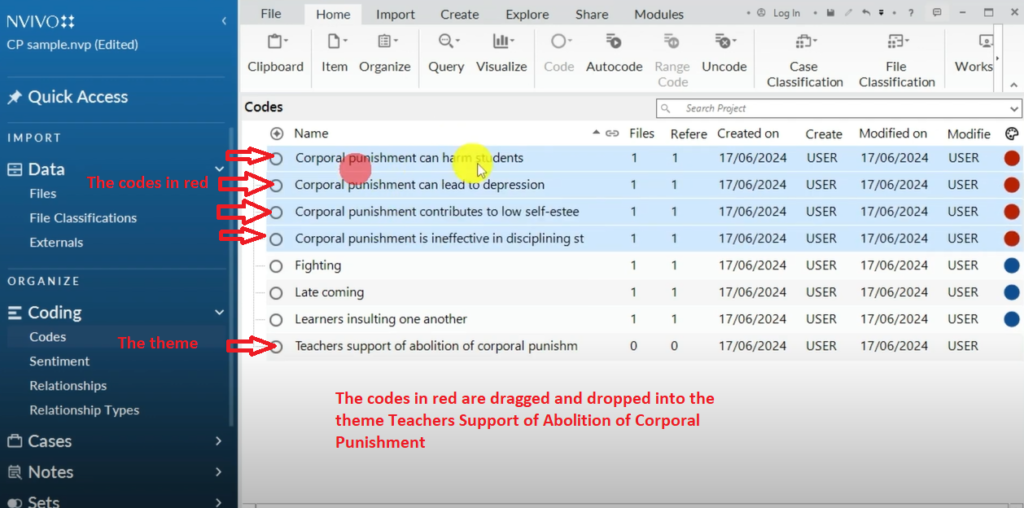
A Description of the Dragging and Dropping of the Codes in the Theme Teachers Support of Abolition of Corporal Punishment
Now this is a theme. Why is it a theme? Because we have dragged and dropped codes under it.
We are trying now to look for a pattern of shared meaning between our codes to form themes.
Another theme we can create comes from the codes colour coded blue. The codes are fighting, late coming, and learners insulting one another.
These are examples of indiscipline in school, and that one also, we can get the question to get an idea of this theme.
The question where the codes came from is: What type of discipline problems are common in your school?
So, we can say, this one are common discipline problems in schools.
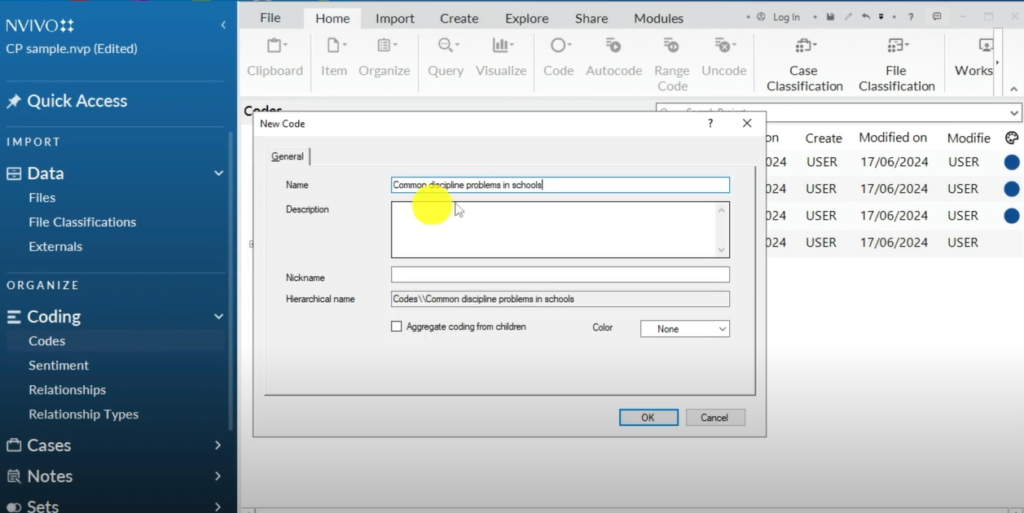
The Theme Common Discipline Problems in School is Created
Now we can go to these three codes that we color coded in blue meaning they have a shared pattern of meaning.
Drag and drop them in the theme common discipline problems in school.
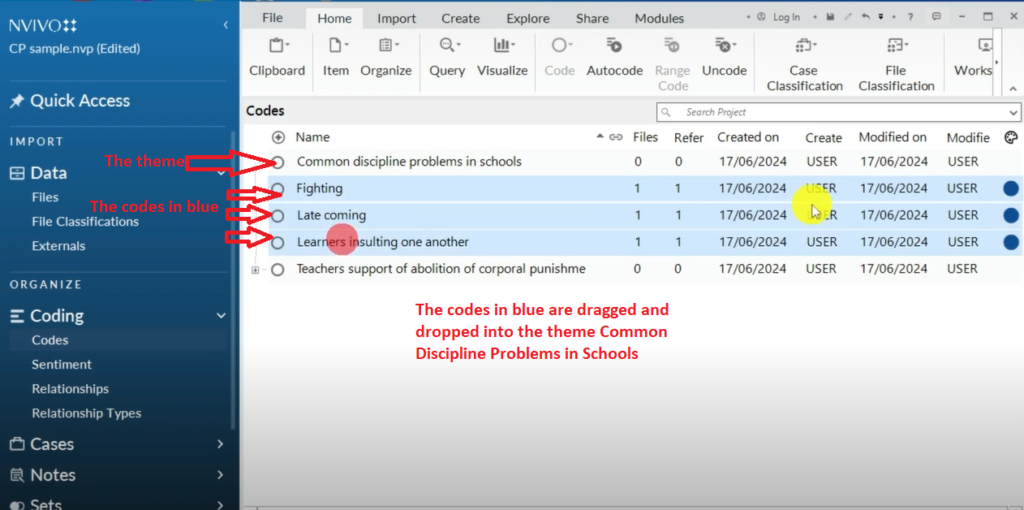
A Description of the Dragging and Dropping of the Codes into the Theme Common Discipline Problems in Schools
So, this is how we form themes. We look for a shared pattern of meaning between codes to get themes.
But when you are conducting qualitative analysis. Please ensure that you colour code your codes.
So that codes that come from the same question have same colour codes.
So that you can be able to look for a pattern of shared meaning between the codes to classify them together.
Basically, this is how we generate initial themes.
Reviewing and Refining Themes
Now the next step in conducting thematic analysis or inductive thematic analysis through the Brown and Clark six step framework is to reviewing and refining themes.
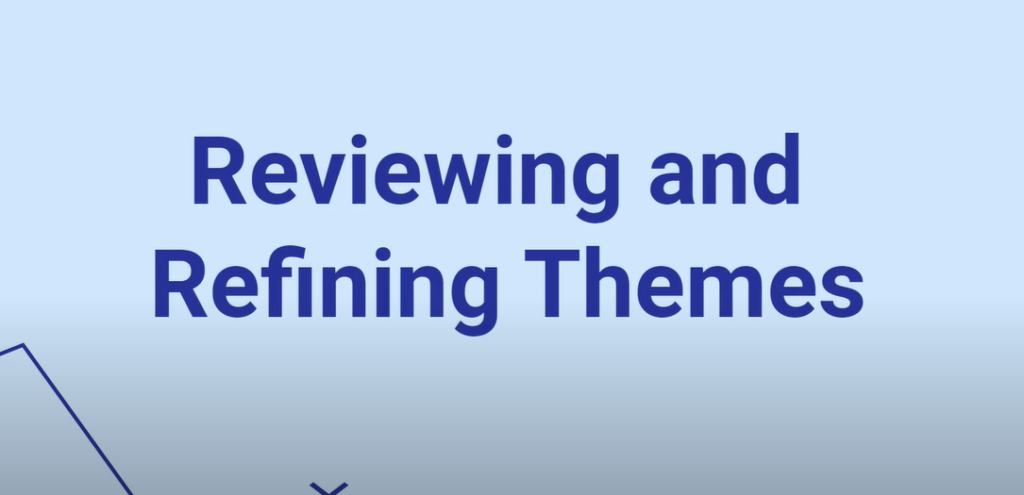
Reviewing and Refining Themes
We go to our themes, and start reviewing and refining them.
For example, this theme, teachers support on the abolition of corporal punishment in enforcing discipline in their schools.
In some instances, I might find that different codes can be merged together to form a sub theme.
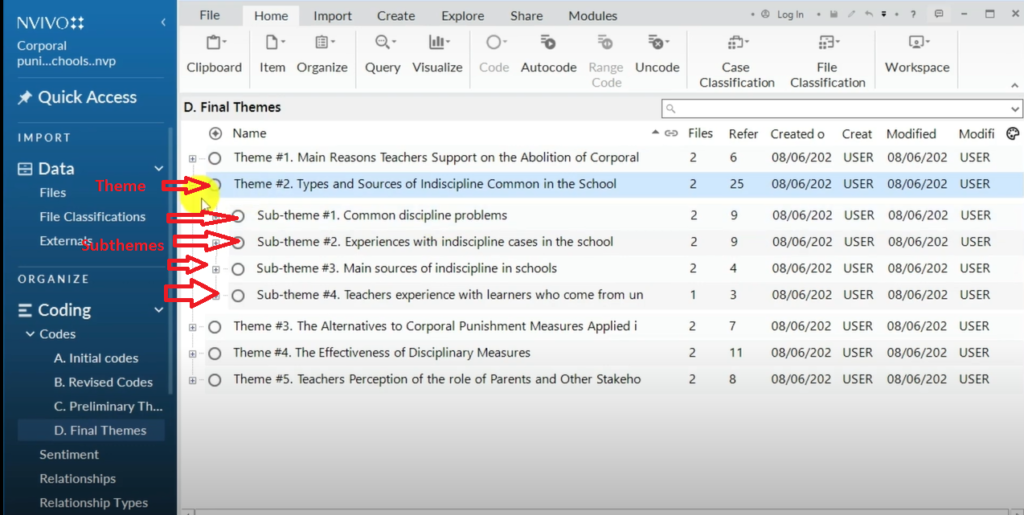
Subthemes and Themes in Nvivo 14
I keep revising, until they sound the way I want.
In the fourth step, we are doing now the second cycle of coding where we are looking for our codes, which ones are the best or which ones are not
We are combining together codes with similar meaning through the process of inductive thematic analysis. We are eliminating codes that do not make sense.
We are reviewing, we are deleting, we are merging. And finally, you can see in some instances I have themes and codes, and in some instances, I have sub themes.
In other instances, we even have areas with categories.
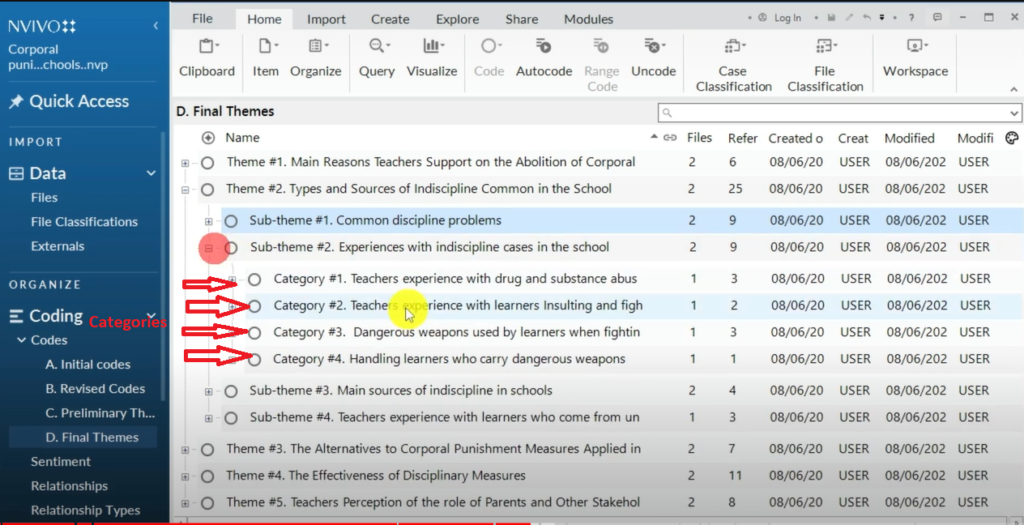
Categories after Data Analysis in Nvivo 14
So, we can move from theme to sub theme to category to codes depending on a shared pattern of meaning.
This is the fourth step of the Braun and Clark six step framework. thematic analysis, which is reviewing and refining themes.
Defining Themes
Now the fifth step of inductive thematic analysis is adding descriptions or clearly defining your themes.
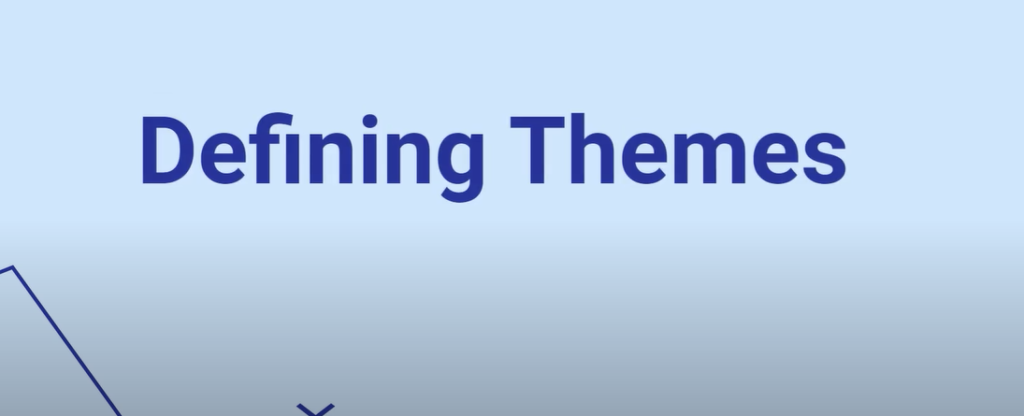
Defining Themes Image
If you go to theme one, my theme, go to code properties, you will see I’ve added very clear descriptions of every theme. Even sub themes in many instances.
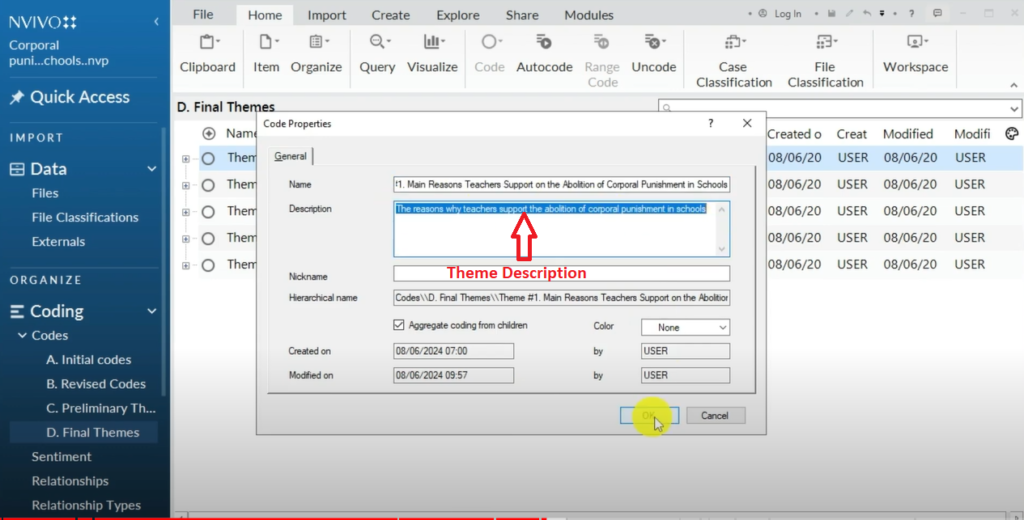
Theme Description in Nvivo 14
When we are reviewing and refining themes, we are clearly checking our work one more time, looking for the agreement between codes to form a pattern of shared meaning, which forms sub themes, and then looking for a pattern of shared meaning between the sub themes, which forms themes.
Then we are providing very clear descriptions of our themes.
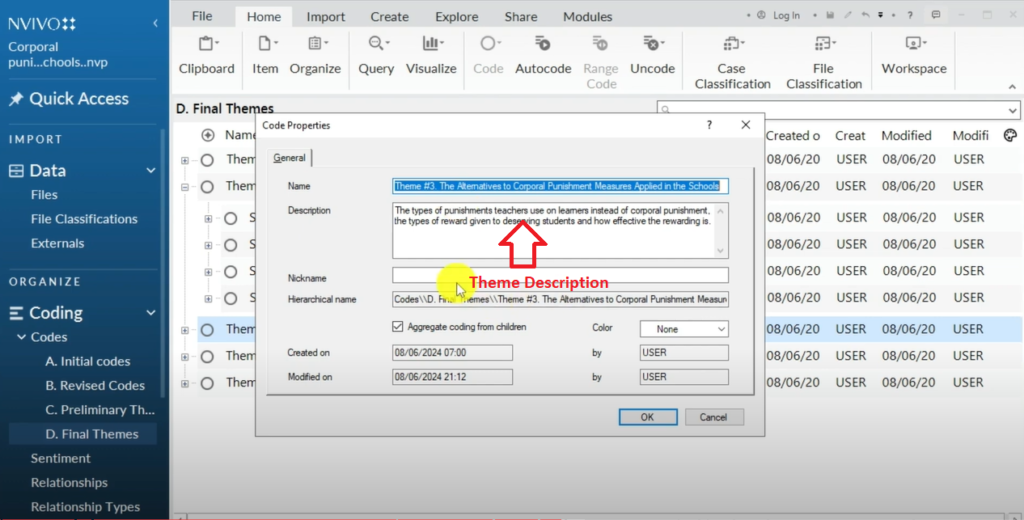
Theme Description in Nvivo 14
Writing the Findings Report
Now, the sixth and final step in conducting inductive thematic analysis, is, writing or coming up with the findings report.
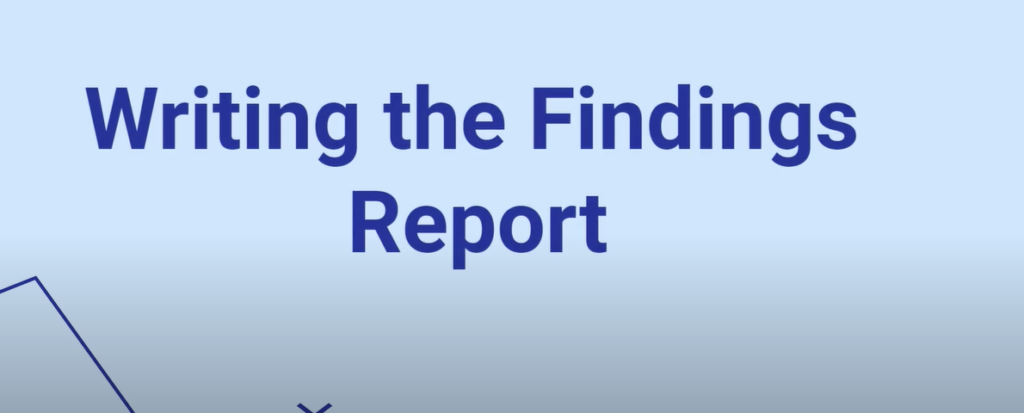
Writing the Findings Report Image
I want to show you the findings report that I came up with. This is my findings report which includes the data analysis process.
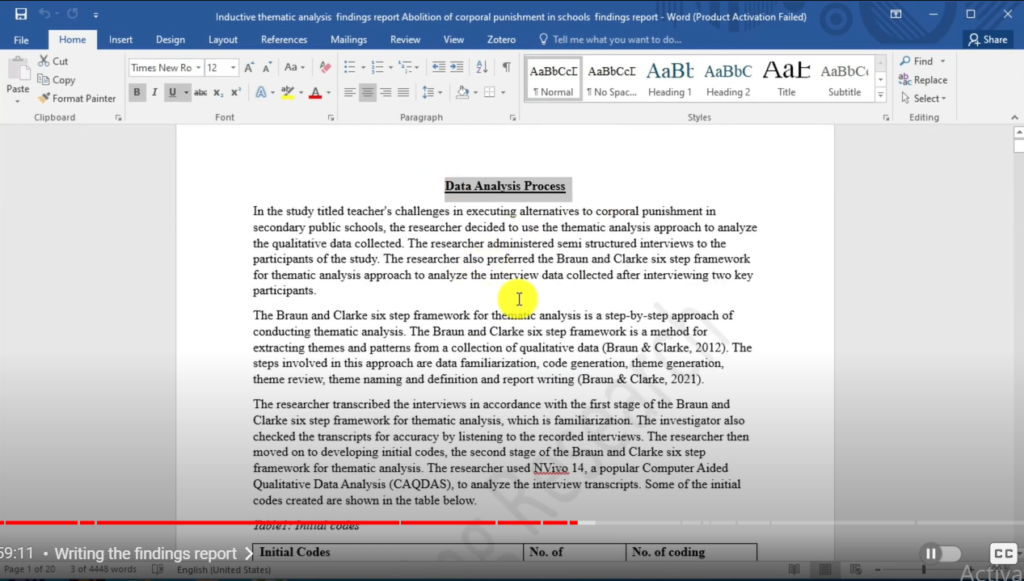
A Section of the Findings Report
Now, we have some visuals such as tables.
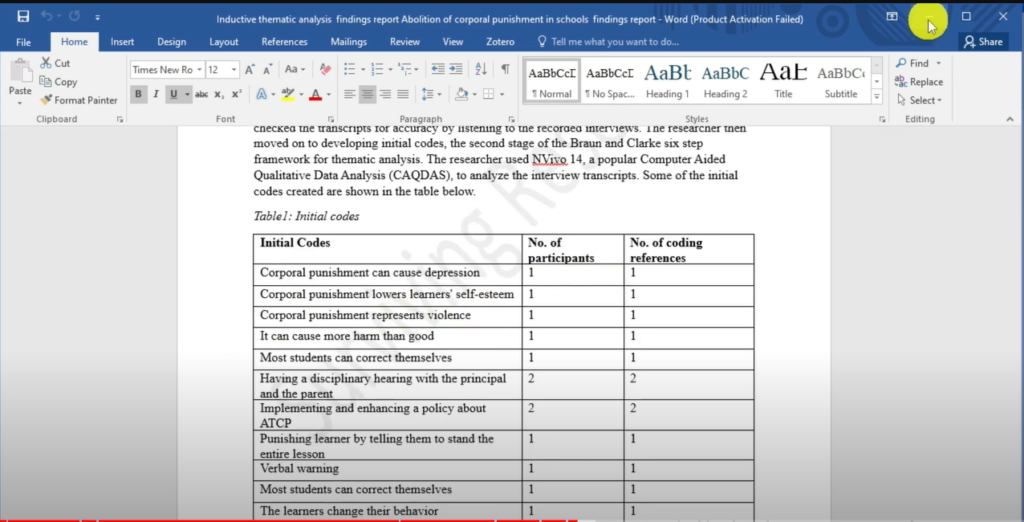
A Sample Table in the Findings Report
When I finish my work, the first thing that I do is I come to my final themes, I click control A on my windows, go to export, then, export list.
I’ll get the Excel. This is an Excel showing the coding structure and important numbers.

An Excel List after the Data Analysis
Files is participant. References are the statements, participant quotes.
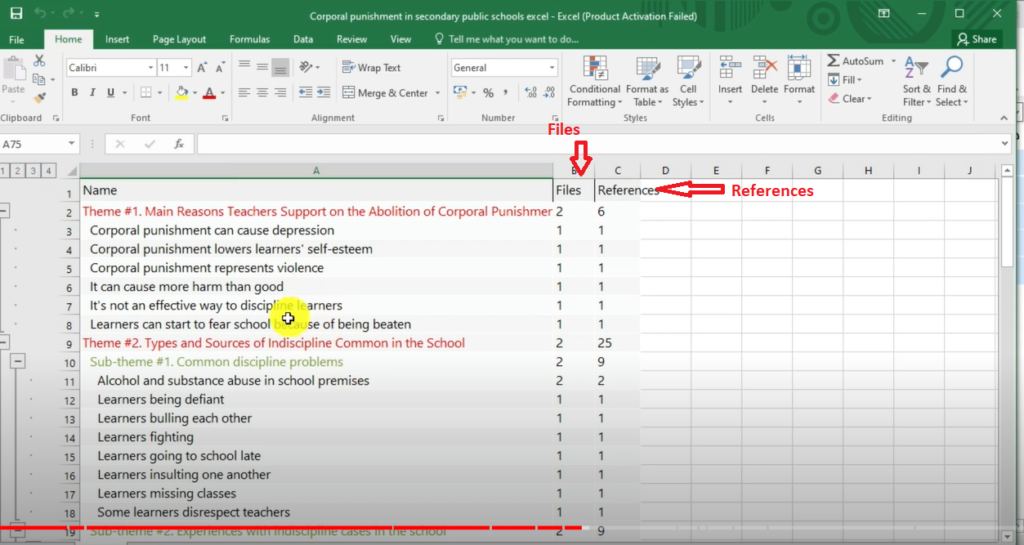
Files and References in the Excel Sheet
I will use this for tables.
The first step of my findings report is to describe or to explain the data analysis process another person can come and read this and understand.
We also add the codebook in the report.
You can go to share, export, export codebook.
Let me show you the codebook also this is the code book. The code book includes any description that we provided for our codes.
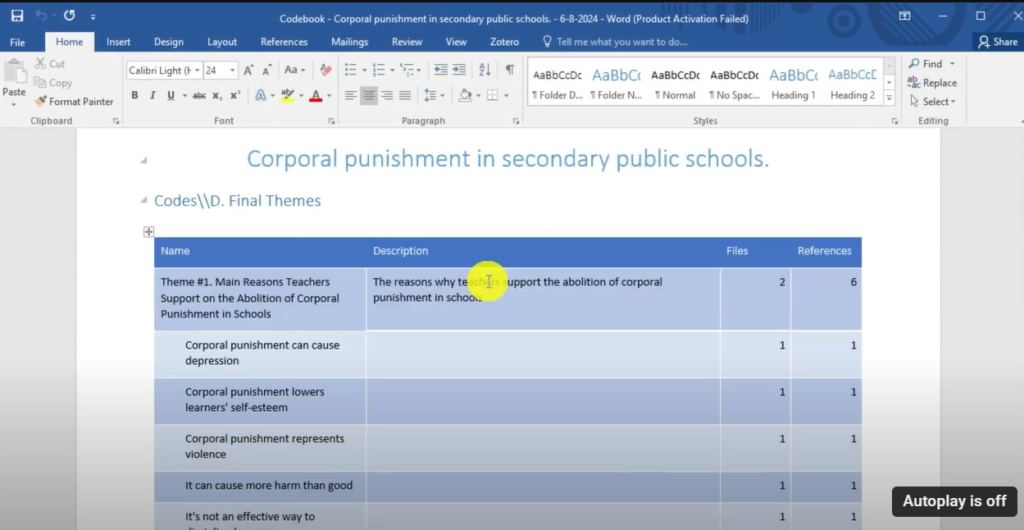
A Codebook Derived from Nvivo 14
The code book and the code list can be attached in the appendix to support the work that we do.
Check out this link to access the complete findings report Inductive and Deductive Thematic Analysis Resources
Sometimes I draw something like this called mind map.
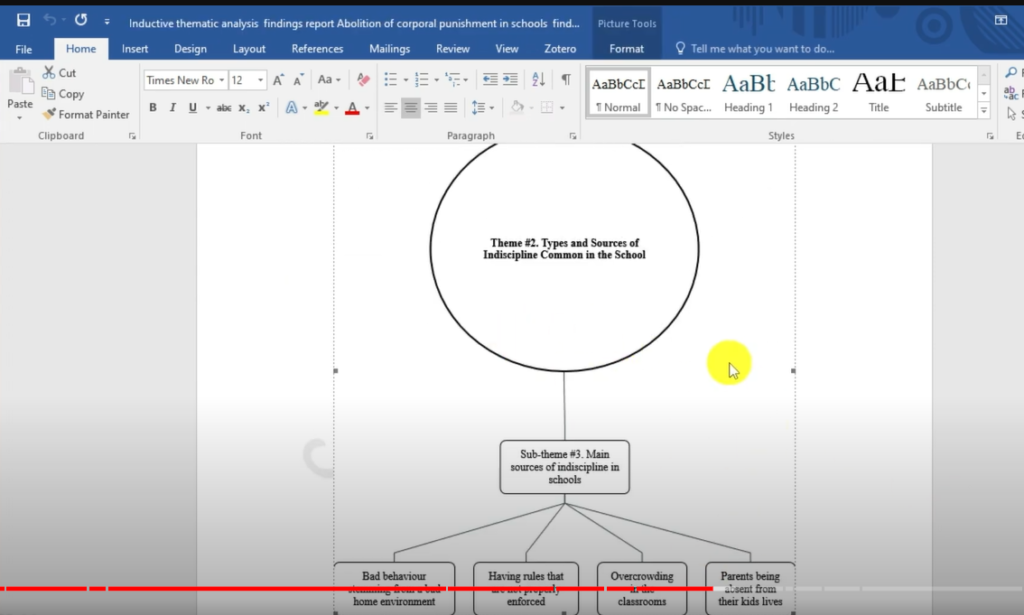
A mind map in Nvivo 14
Check out this link to understand how to come up with different visuals 9 Ways to visualize in Nvivo.
Now that’s how you conduct thematic analysis.
We went through the six steps of conducting inductive thematic analysis and we used the Braun and Clark six step framework which includes; familiarizing with the transcripts, generating initial codes, generating initial themes, reviewing and refining themes, providing clear definitions and descriptions for themes, and finally writing the findings report.
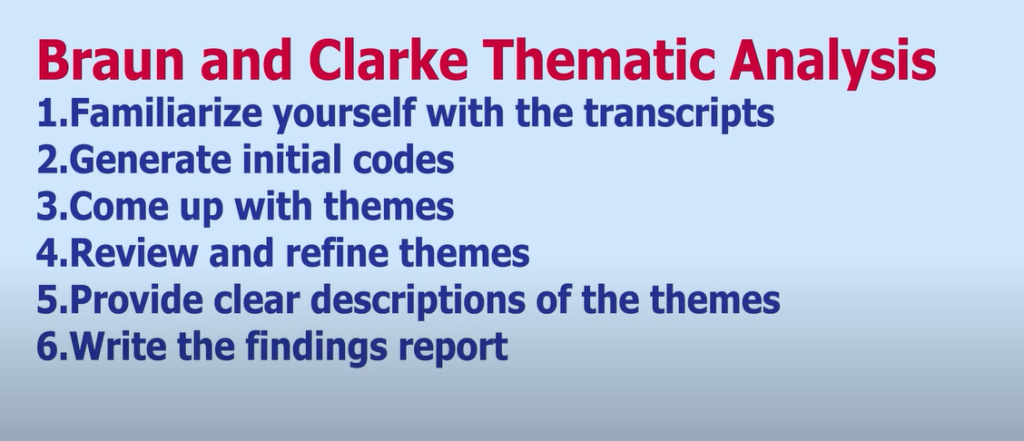
The Braun and Clarke Six Step Framework Image
Deductive Thematic Analysis
Now, let’s look at the second main approach to thematic analysis, which is the deductive approach.
The deductive approach to thematic analysis involves developing a predetermined set of themes and sub themes and then diving into the qualitative data to look for codes to match the predetermined set of themes and sub themes.
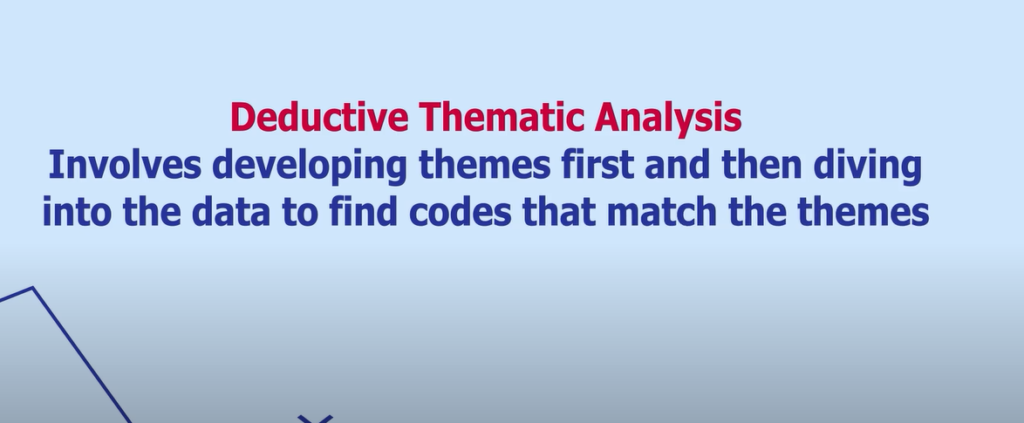
Deductive Analysis Description Image
The deductive approach is mainly informed by empirical research, existing theories or prior knowledge.
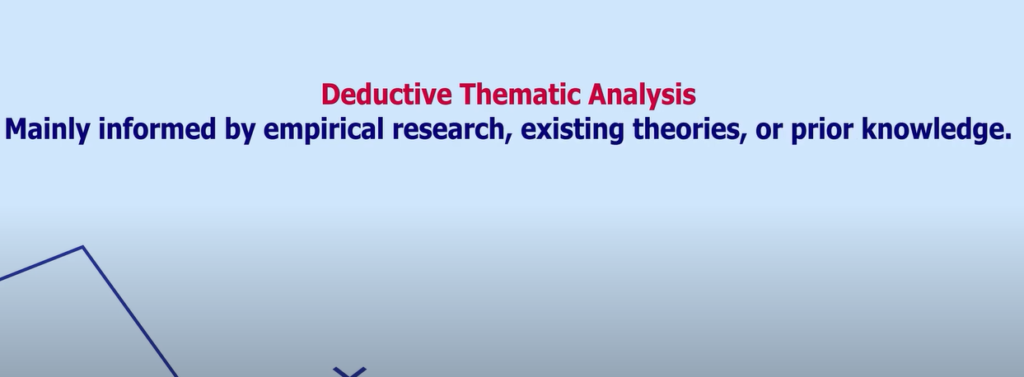
Deductive Analysis Description Image
The deductive approach is there for suitable when researchers are conducting confirmatory research, where they have structured interviews and want to find out specific information.
An example of the deductive approach to thematic analysis is the codebook approach.

Codebook Approach as an Example to Deductive Analysis
We are going to use the codebook approach to conduct deductive thematic analysis through the following steps:
- Identifying theoretical frameworks or research area.
- Developing coding schemes or codebook, which is made up of themes.
- Developing a clear description of the themes.
- Generating codes and assigning them to themes.
- Reporting the findings
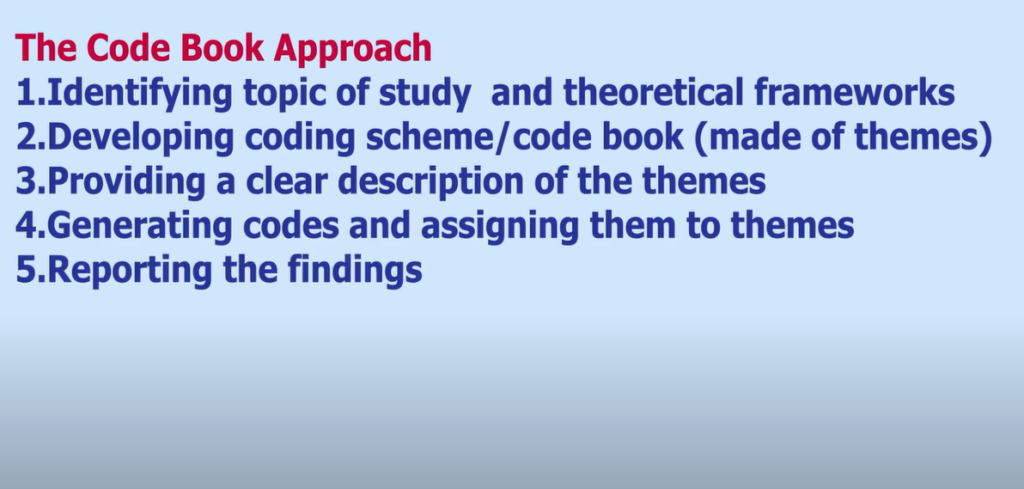
The Steps of the Codebook Approach Image
Identifying the Topic of Study or Theoretic Framework
Let’s look at the first step of conducting deductive thematic analysis, which is identifying the topic of study or theoretical frameworks.

Identifying the Topic of Study/ Theoretical Framework Image
I want to give you an example, this is a study or the sample study I’m going to use for this video, which is I’m conducting a confirmatory study in which the researcher is trying to assess the impact of concurrent verbalization.
Let me just explain, although this is not your discipline, what concurrent verbalization is.
Concurrent verbalization is also known as thinking aloud, is a technique where participants verbalize their thoughts while performing a task
Such a study, therefore, lends itself to the deductive thematic analysis because it’s a confirmatory study which assesses the impact of a given phenomena or the impact of concurrent verbalization.
That’s the study I’m going to analyze.
Now we have a topic of study or a theoretical framework.
Developing the Codebook
Now, we move to the second step of deductive thematic analysis. The second step in deductive thematic analysis is coming up with a code book.
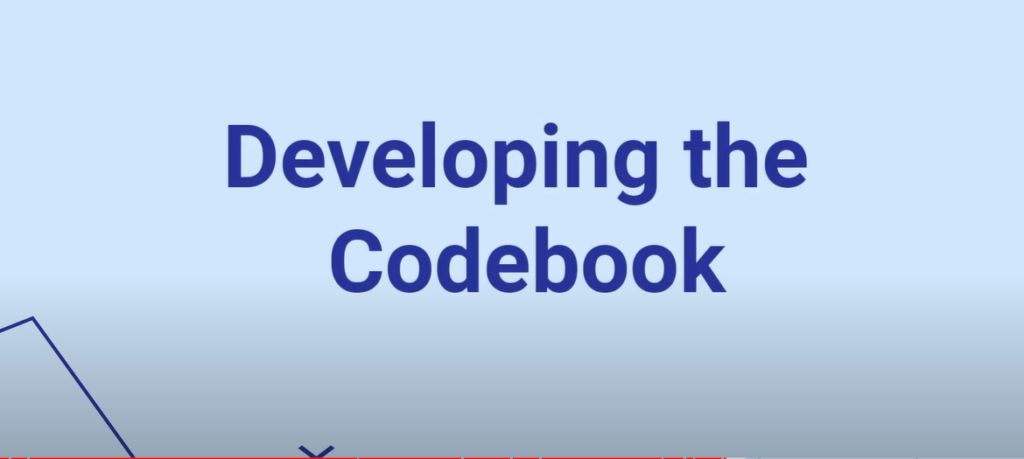
Developing the Codebook Image
Now, when you are conducting deductive thematic analysis, you will use the questions that were asked to come up with a kind of a code book, you can see the questions that were being asked.
The questions that were asked included;
- Which chapter did you focus on during your concurrent verbalization sessions?
- How do you feel the writing of the chapter went?
- What challenges did you encounter when writing the chapter? Is there something you can expand on in addition to the ones you’ve just discussed?
- Other comments that you have about how the concurrent verbalization went
We can now develop a codebook from the questions.
For question 1, we will call the theme; Chapters of focus during concurrent verbalization. We then provide a description for the theme.

The Theme Chapters of Focus During Concurrent Verbalization Sessions is Created
For question 2 we will call the theme; Author experiences writing a chapter. We then provide a description for the theme.
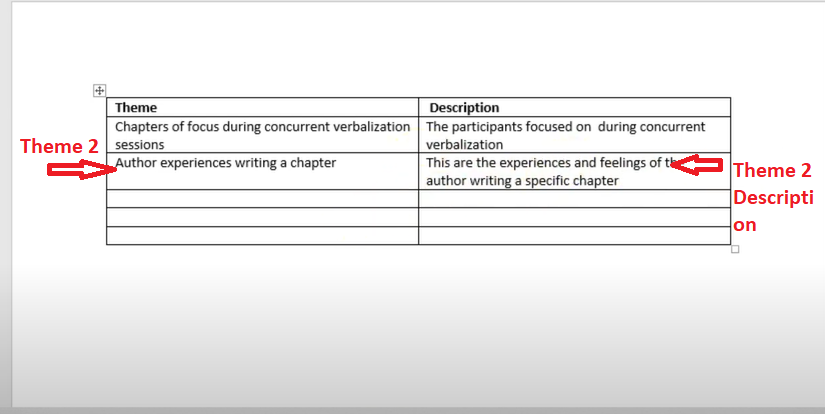
The Theme Author Experiences Writing a Chapter is Created
For question 3 we will call the theme; challenges experienced by the author during the writing experience. We also provide a description for the theme.
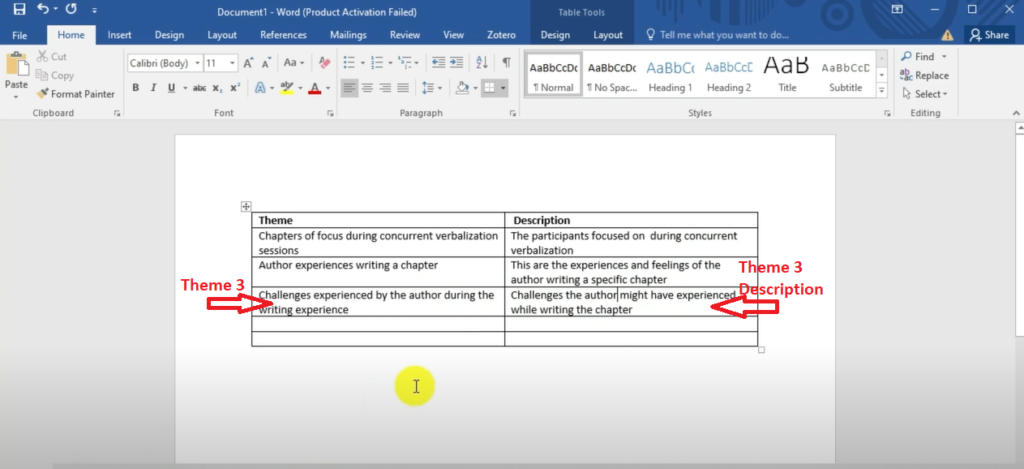
The Theme Challenges Experienced by the Author During the Writing Experience is Created
For question 4 we will call the theme; author experiences during concurrent verbalization. Then we provide a description for the theme.
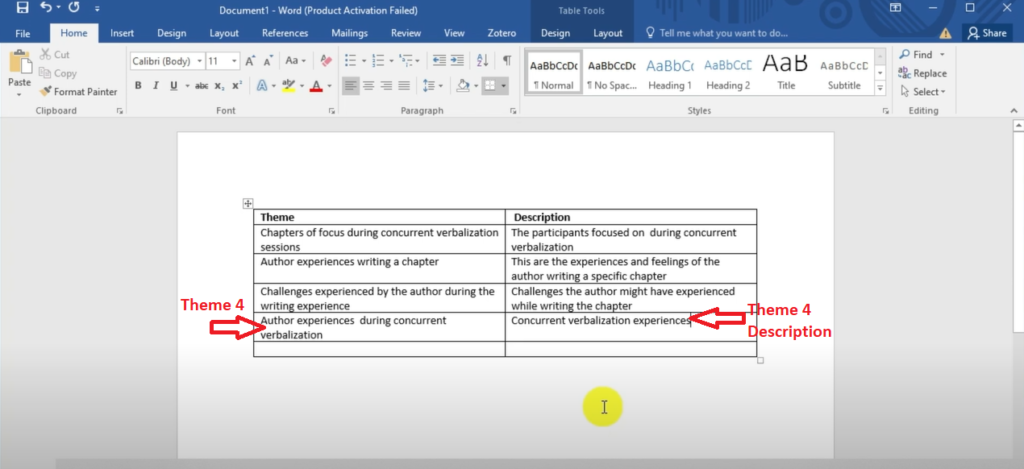
The Theme Author Experiences During Concurrent Verbalization is Created
That’s how we develop the code book.
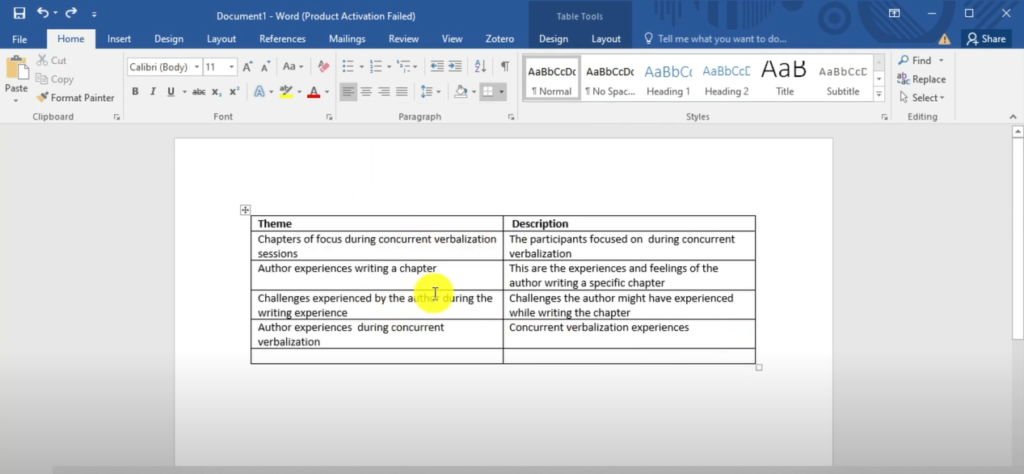
The Complete Codebook
So that is the second step of deductive thematic analysis.
While developing the code book I have done the third step, which is providing a clear description of the themes.
Generating Codes and Assigning them into Themes
Then we go to the next step of fitting the data into the themes.

Generating Codes and Assigning them into Themes Image
To fit the data into the themes we use a software called Nvivo for data analysis. This is Nvivo.
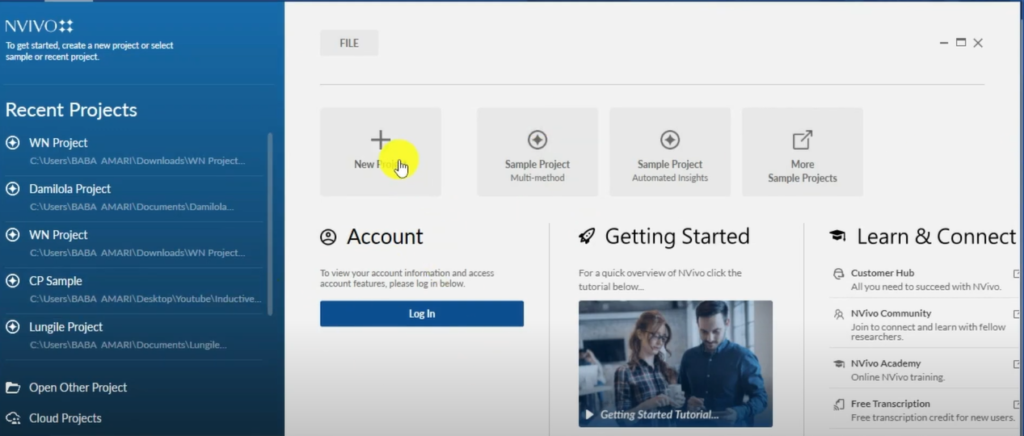
Nvivo 14 Screenshot
We open a new project. I want to call this project Deduct. Then I click on Next
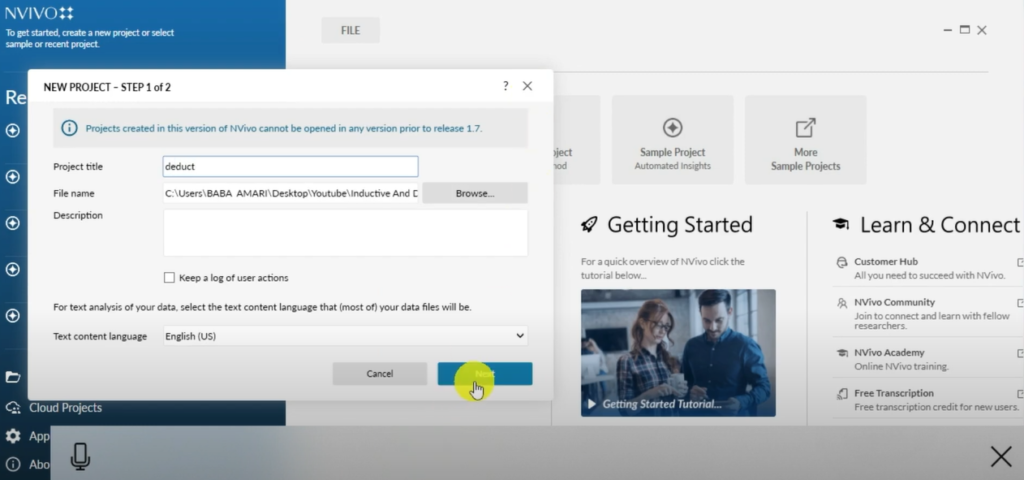
Creating Project Deduct
We are going to import our transcript.
There are two ways to import transcripts. You can go to import, and go to files, import there, or you can drag and drop the transcripts in the files section.
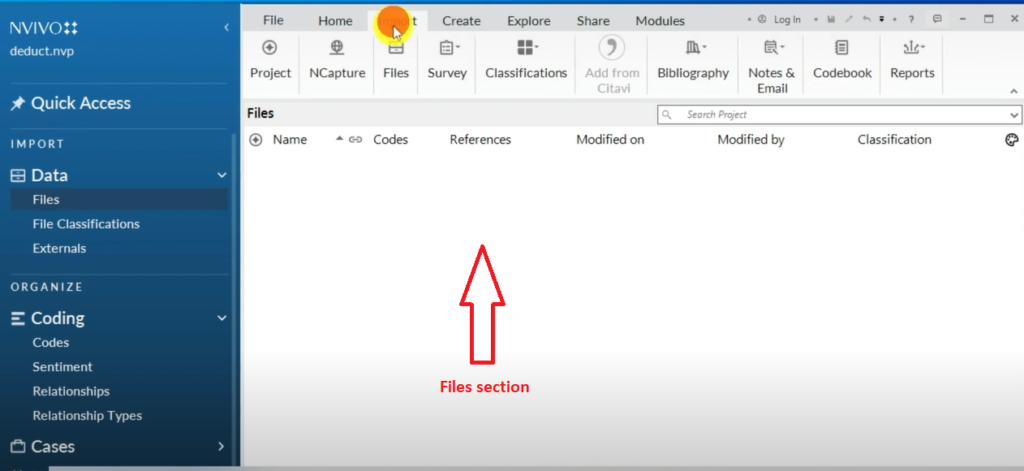
Files Section in Nvivo 14
We have the file in the files section.
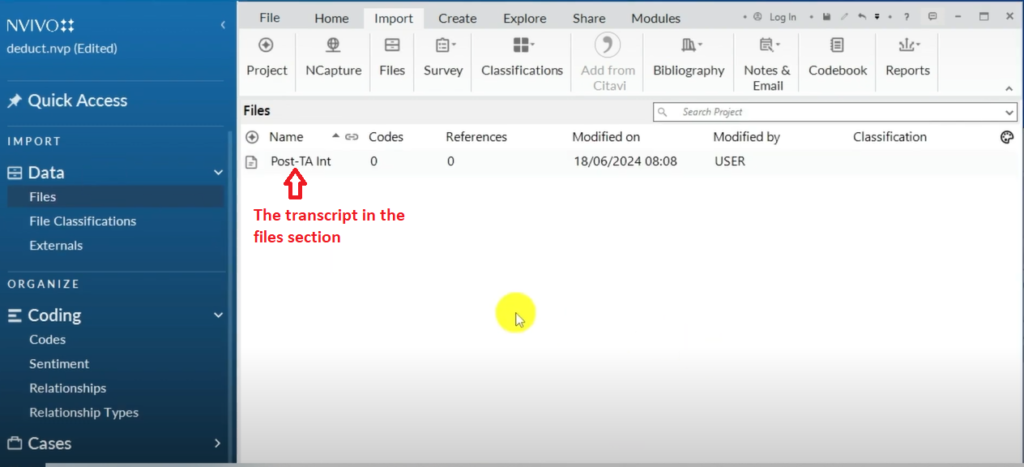
The Transcript in the File Section
Now, we are going to come and start analyzing.
For deductive thematic analysis, after we import the transcripts, the next thing we do is to add the code structure into Nvivo, because for deductive thematic analysis, it’s an issue of getting the coding framework in the codes section, then going and getting codes and fitting them into the coding framework.
What do I mean? This is the code book we just created.
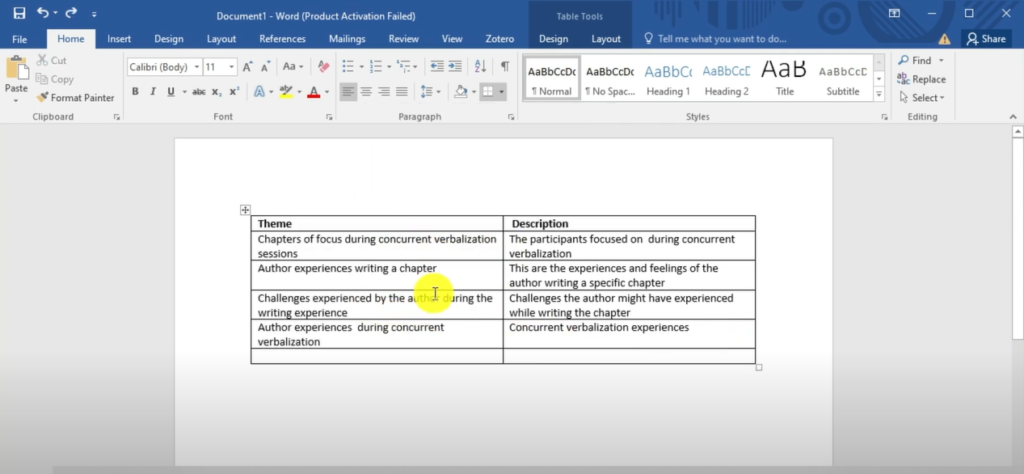
The Codebook
This is the first theme
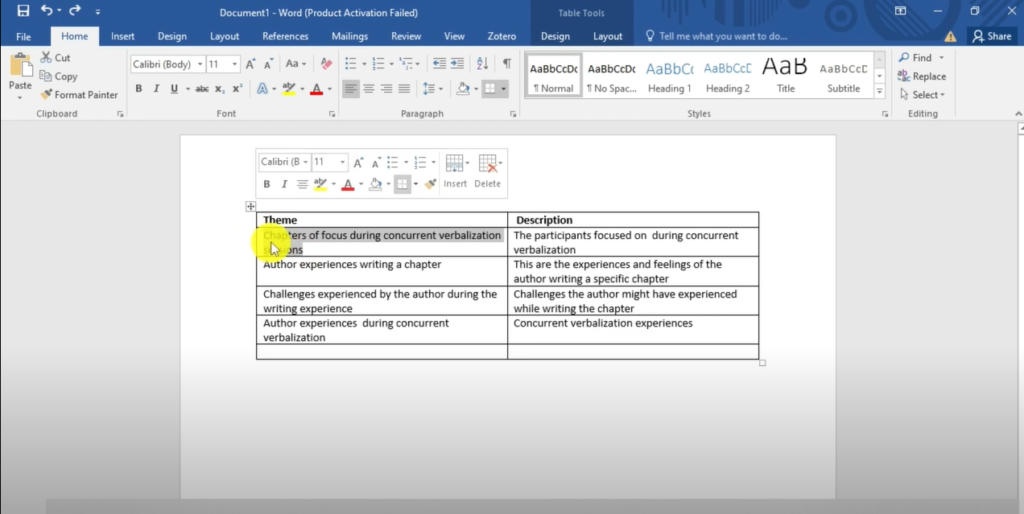
The Highlighted First Theme
Let me copy that theme.
Let me come to Nvivo. I’m in the code section.
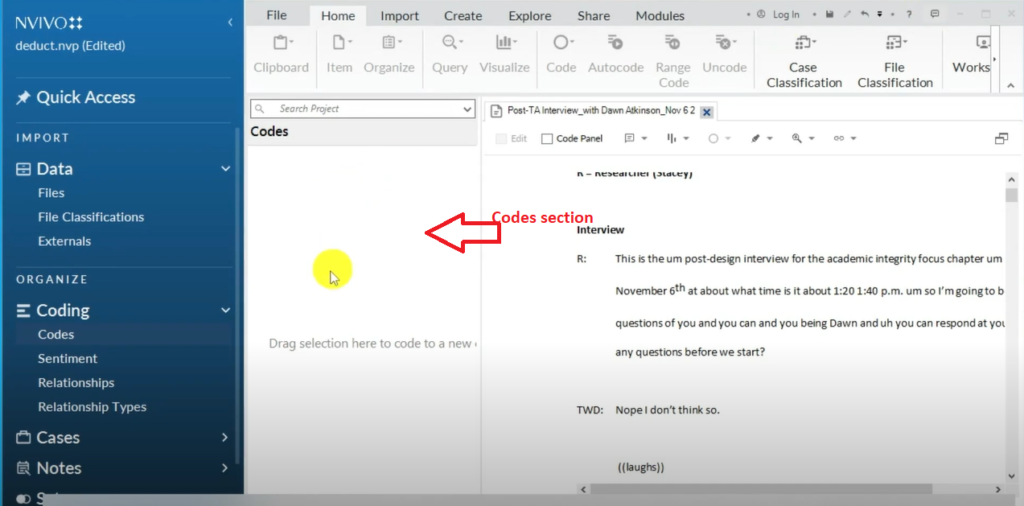
The Codes Section
Right click. Click on new code and paste theme 1in there. I can call it theme one.
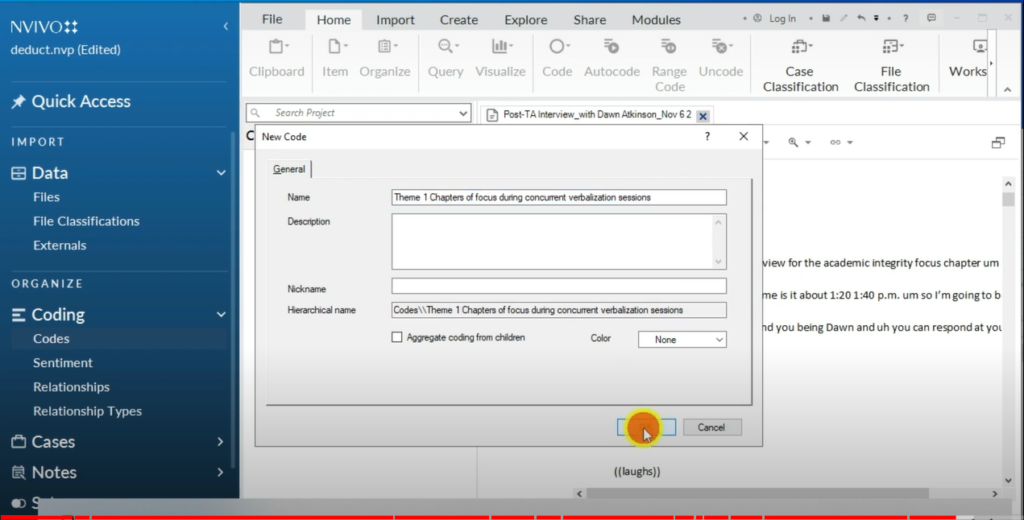
Theme 1 is Uploaded into the Codes Section
Basically, we are bringing the themes that we had in our codebook, into Nvivo.
I want to go to code properties here and I want to add the description for that theme.
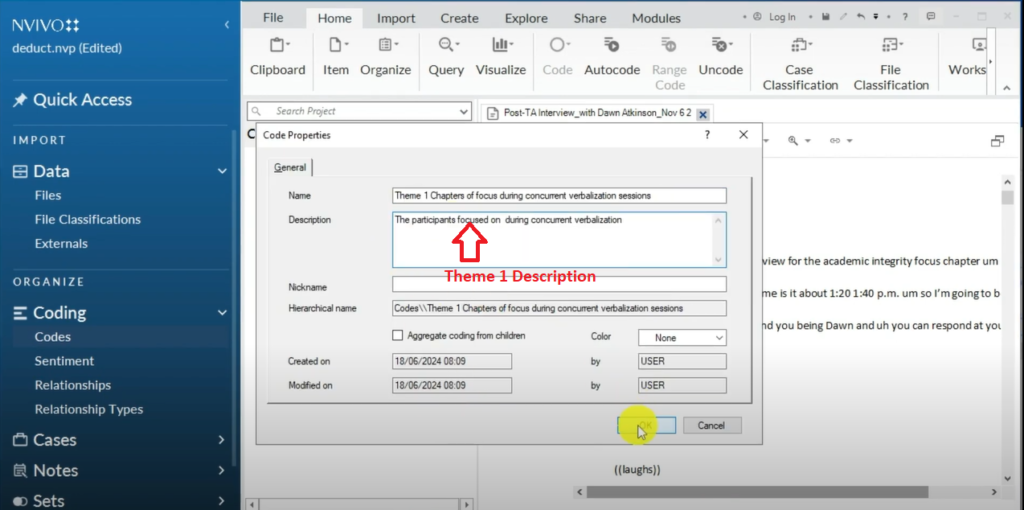
Theme 1 Description
Every theme should have a description.
Then we do the same for the second theme.
Let’s go in here and go to author experiences writing a chapter and then new code, paste, and then I’m going to call this theme number two.
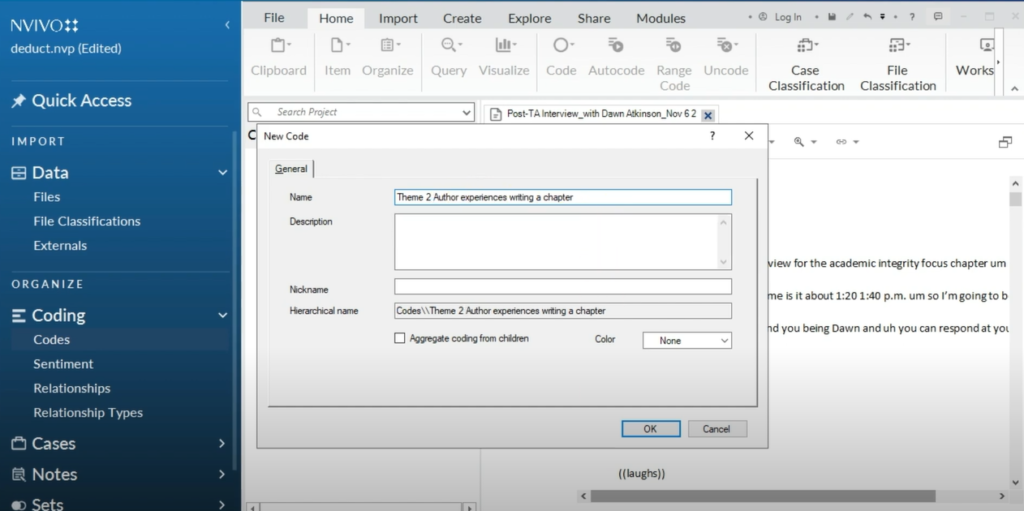
Theme 2 is Uploaded in the Codes Section
And then I’m going to new code and then paste theme number 3 which is; challenges experienced by the author during the writing experience.
And we can call this theme number three.
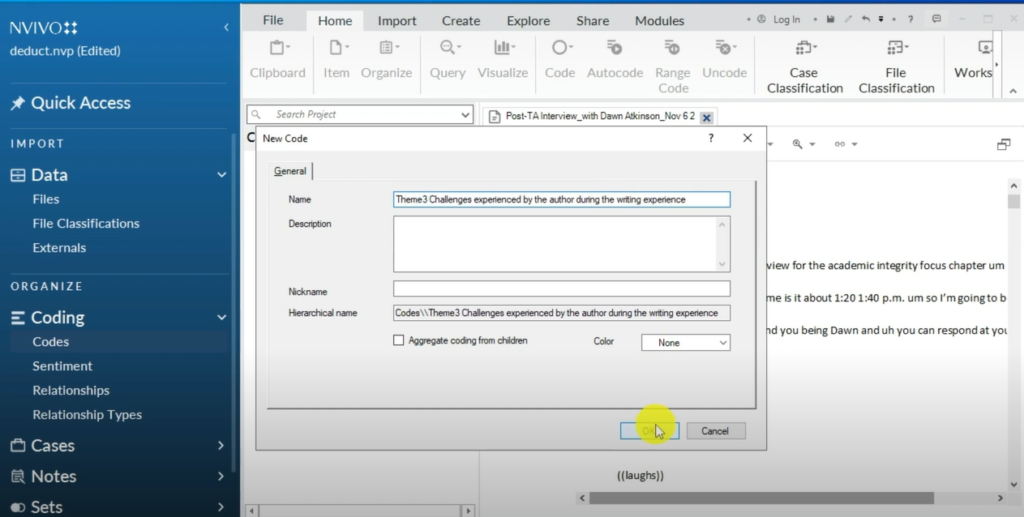
Theme 3 is Uploaded into the Codes Section
And then I’m going to have theme number four and in theme number four, I’m going to have author experiences during concurrent verbalization.
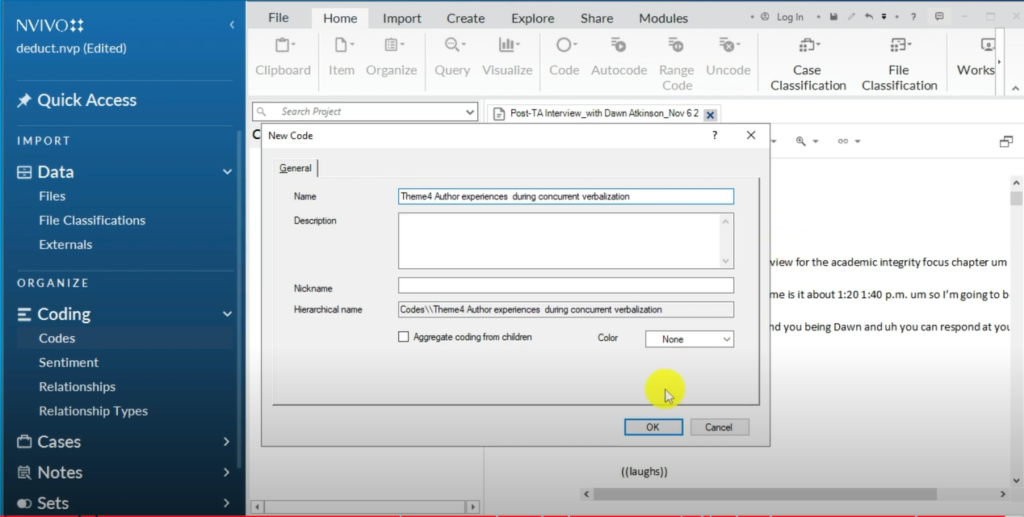
Theme 4 is Uploaded in the Codes Section
Basically, that’s the code structure that I have.
Remember, I’m in the code section of Nvivo you put your themes here.
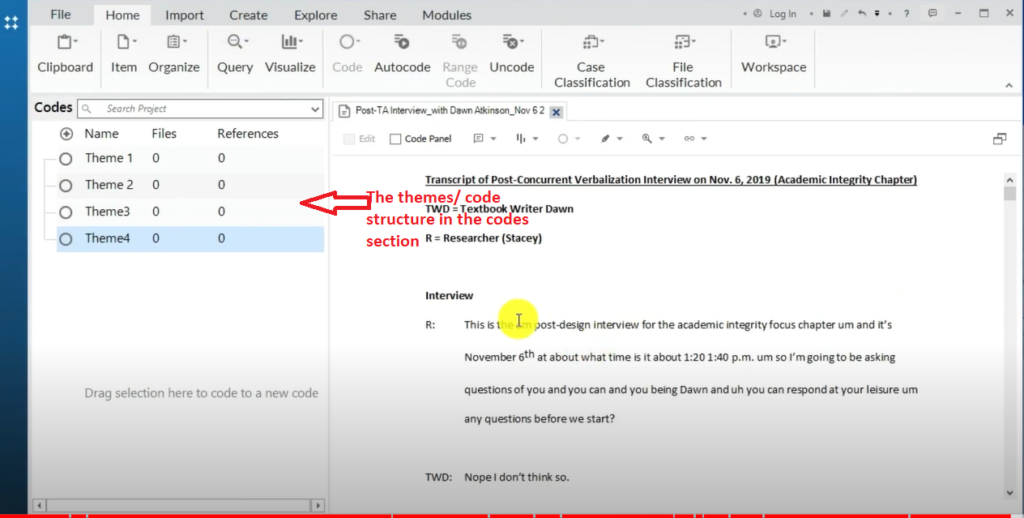
The Themes in the Codes Section
And now, go to the other step, which is, assigning the codes into the themes.
This is deductive, where we come up with the themes a priori, then we find codes to match into the themes.
Let’s look at the interview. Let me start here.
“Which chapter did you focus on during your concurrent verbalization sessions.“
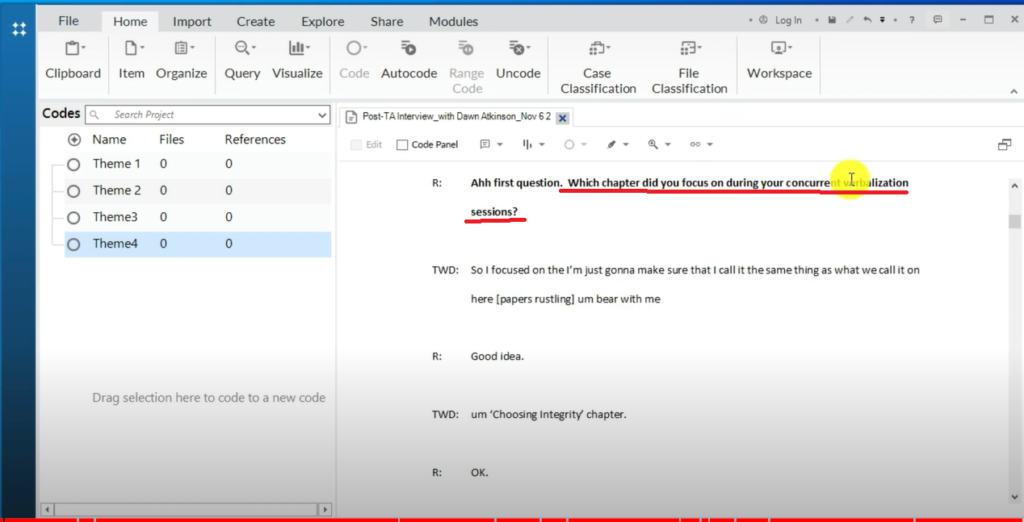
A Section of the Transcript
Choosing integrity chapter.

A Section of the Transcript
Chapters of focus during concurrent mobilization, drag and drop that, it’s choosing, it’s choosing integrity chapter.
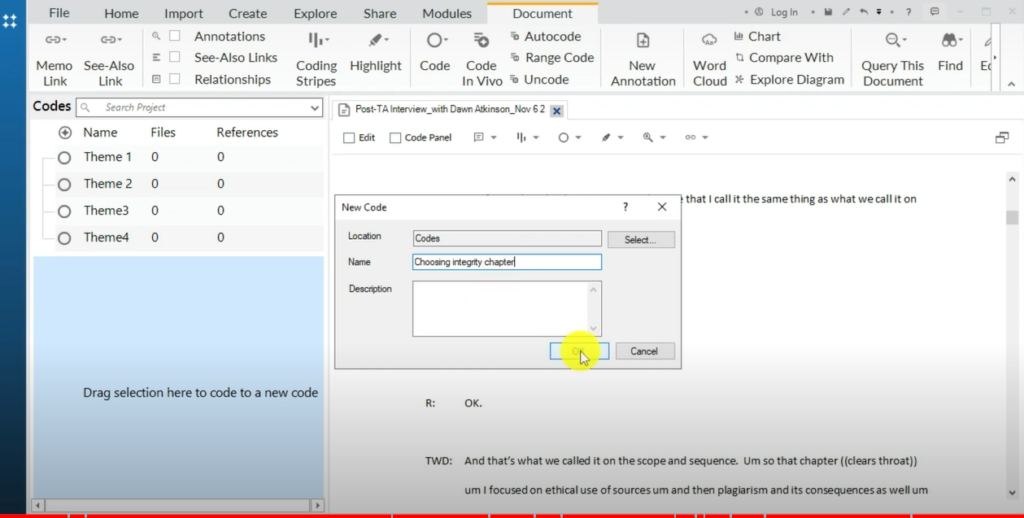
The Code Choosing Integrity Chapter is Created
Now let’s read, “I focused on ethical use of sources.”
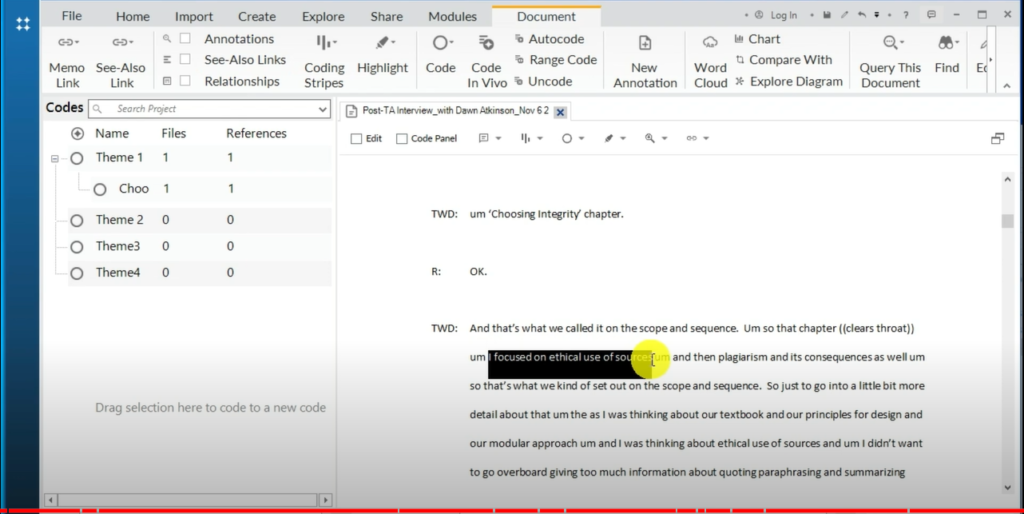
A Section of the Transcript
We can call these issues of focus in the chapter.
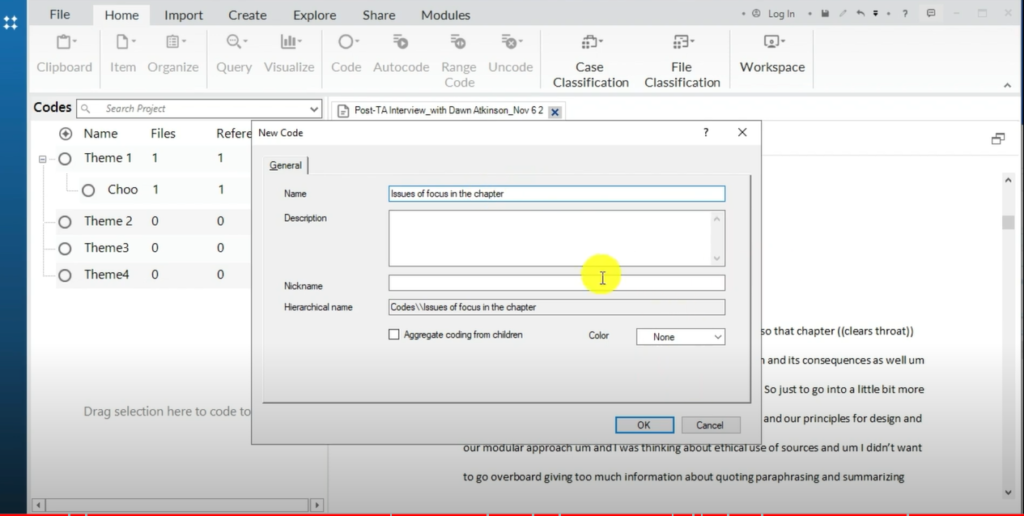
The Subtheme Issues of Focus in the Chapter is Created
That’s a sub theme
So, issues of focus in the chapter I’ll just take this and put it under the theme because under the issues of focus, I want to drag and drop ethical use of sources.
You see, ethical use of sources.
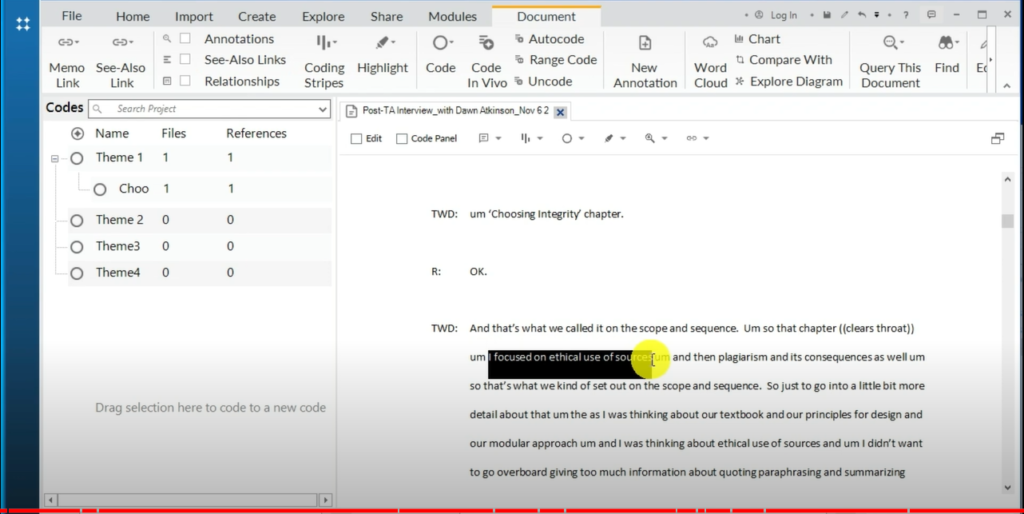
A Section of the Transcript
Drag and drop, it’s under issue of focus.
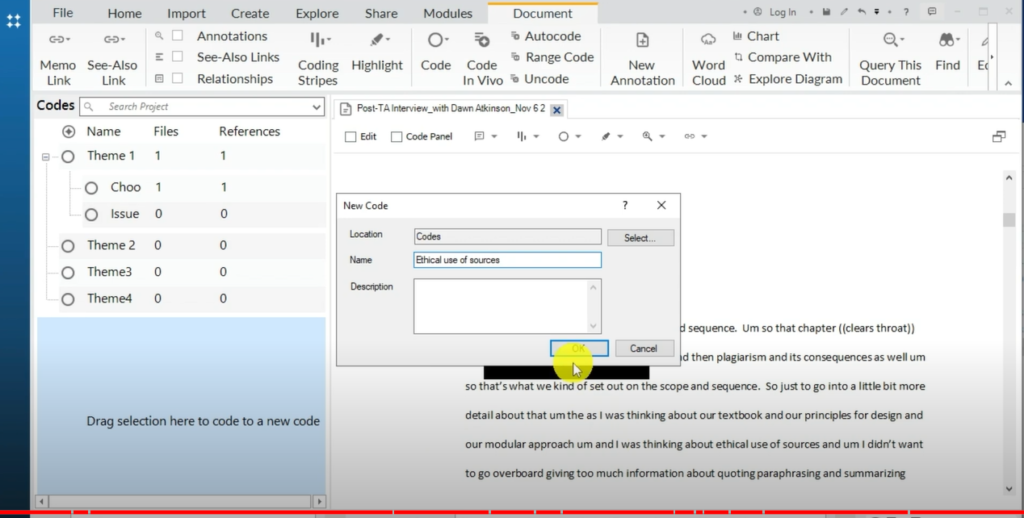
The Code Ethical Use of Sources is Created
Then “plagiarism and its consequences.” Okay. That’s another thing they focused on.
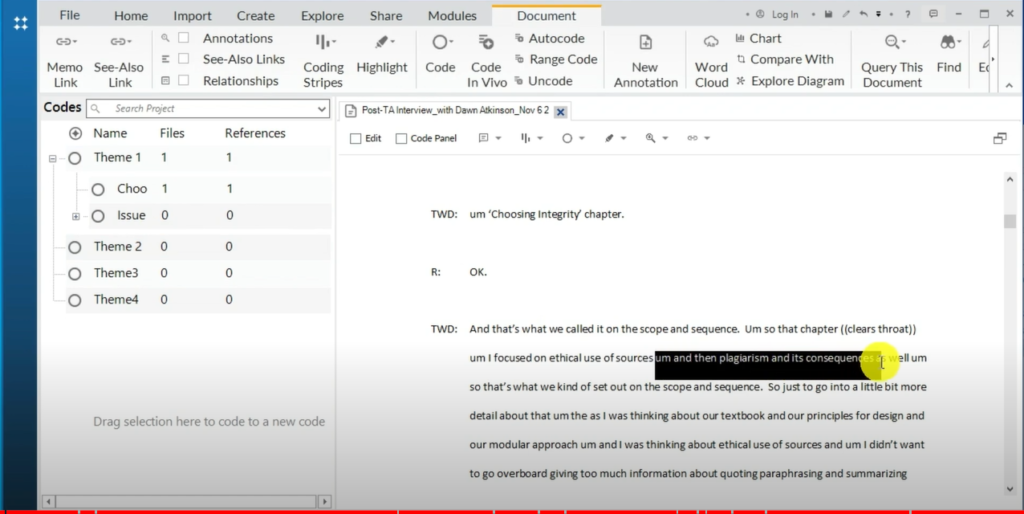
A Section of the Transcript
So, plagiarism and its consequences.

The Code Plagiarism and its Consequences is Created
I go to theme 2
“And how did you feel writing of that chapter went? How did it go?“
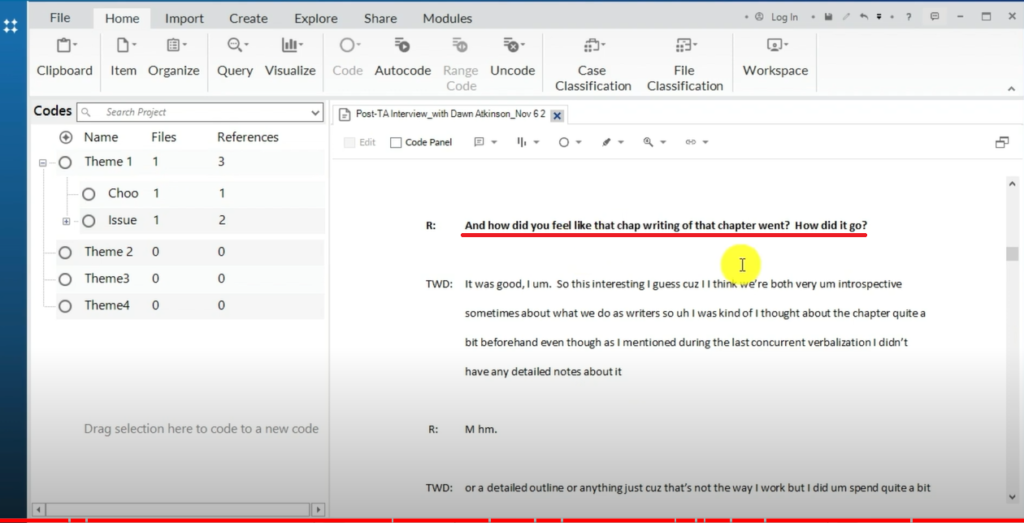
A Section of the Transcript
Uh, “it was good. So interesting.“
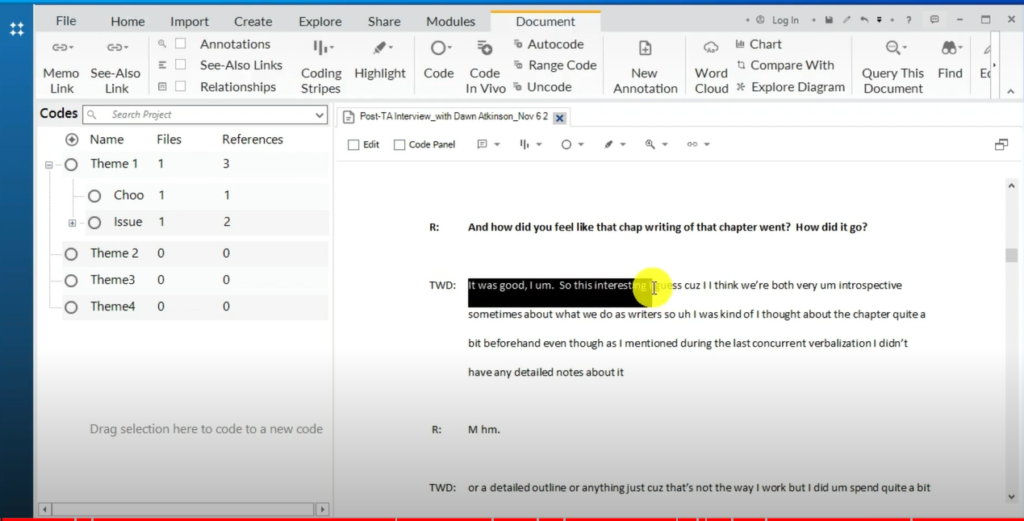
A Section of the Transcript
So, great experience writing the chapter is a code.
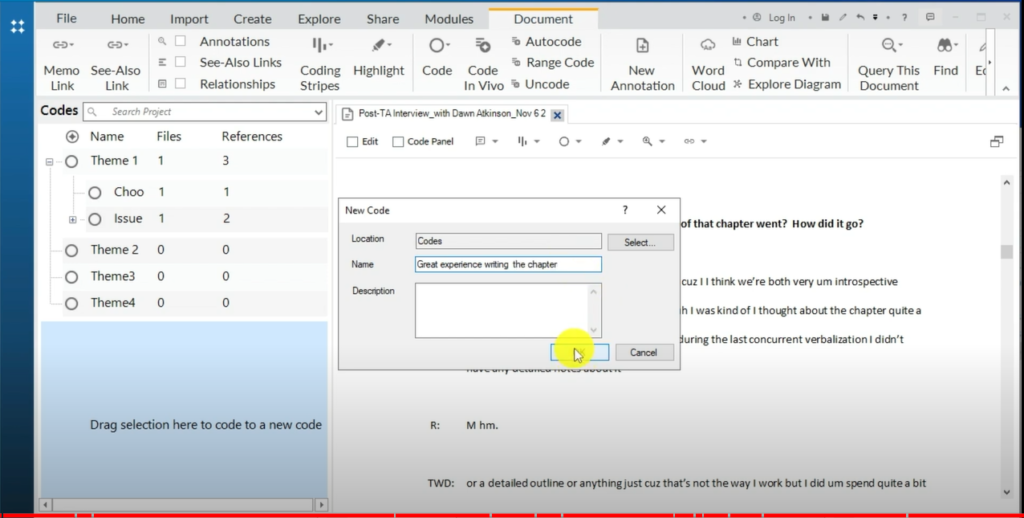
The Code Great Experience Writing the Chapter is Created
Great experience writing the chapter, I drag and drop it in theme 2.
If you read this, “I guess, I think cause we are both very introspective sometimes about what we do as writers. So , I think it was kind of thought the chapter was quiet a bit before hand.”

A Section of the Transcript
So took time to plan for the chapter is a code.
By the way, I can also code by right clicking and go to, code selection; I can put that under theme two. Create a new child code in there and call these what.
Planned for the chapter before writing and go to click create new code. You can see that code will go in there.
So that’s another way. If you can’t be able to drag and drop, that’s another way of creating codes. You highlight the code. You right click. You go to code selection. You put a point, like, I want this under theme then create new child code, then you create.
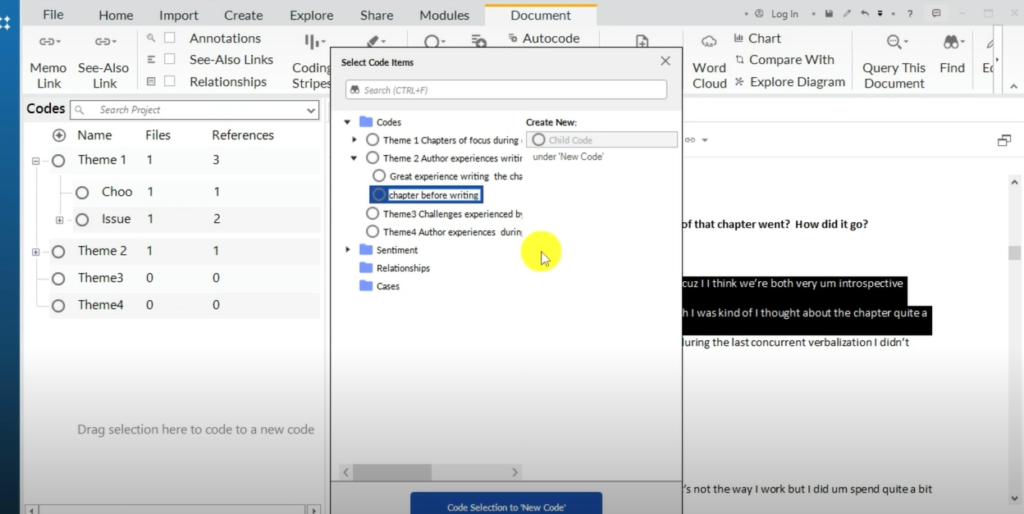
The Code Planned for the Chapter before Writing is Created
So, in deductive thematic analysis, I’m going to go through the full transcript and get all the codes that, and assign all the codes that I will find into the themes that we already established a priori, or before we began analysis.
This is a file and I’ve gone through the whole file and done, and assigned the codes to the main themes.
You can see everything I’ve coded. I’ve coded a lot.
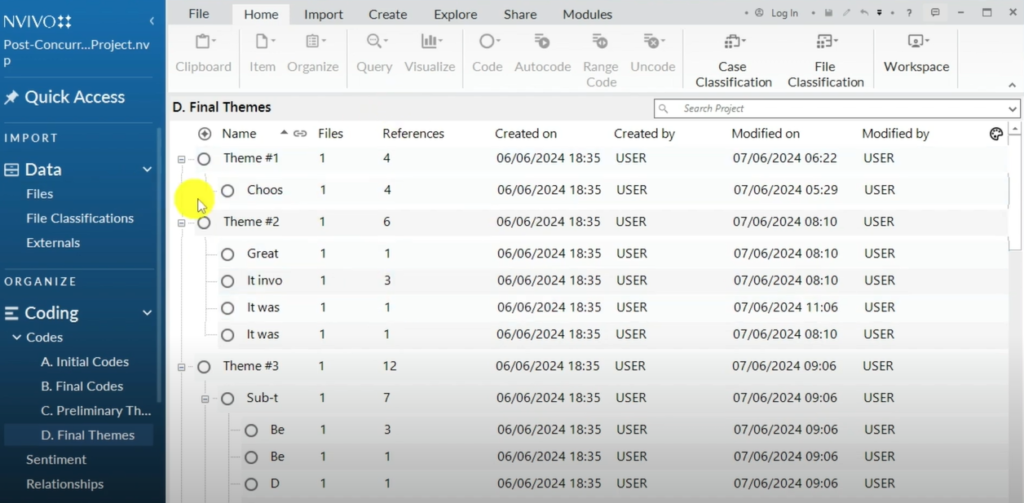
Themes and Codes Generated after the Analysis
Then I kept revising, especially in the codes area.
What was changing are the codes, not the themes.
I can also show you what I did after I completed the coding. I exported an Excel, which I can show you here.
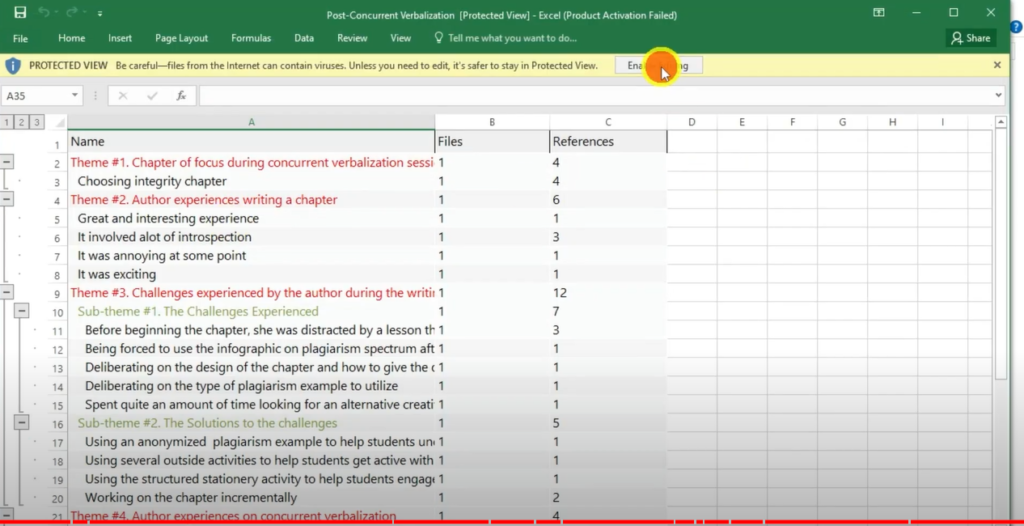
A Code list Showing the Codes Generated after Analysis
How I got the excel is by going to my work.
Going to the final theme section. Then control A on your computer. Then go to export, then export list.
And that’s the themes and the codes. I assigned the codes to the themes which we had established
Reporting the Findings
Now the final step, after we code and we assign the codes into our pre established or pre determined themes, we write the findings report.
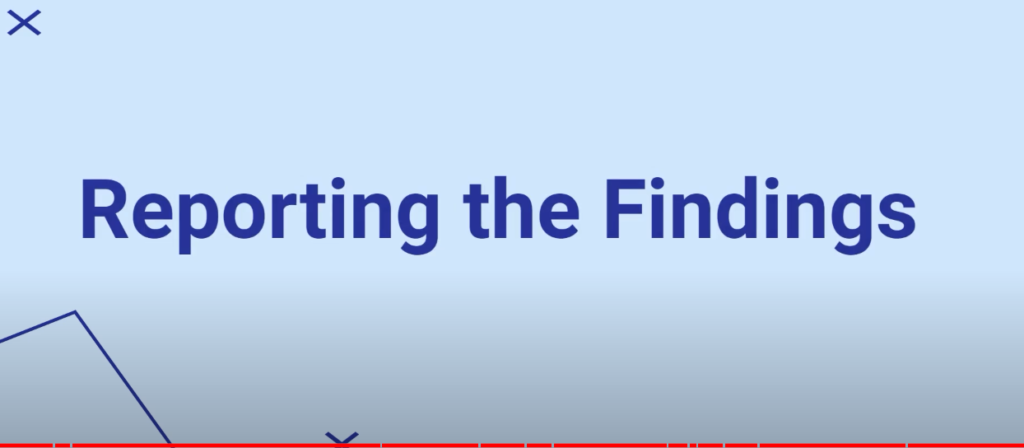
Reporting the Findings Image
I have taken time to write my findings report, which I’m going to show you here.
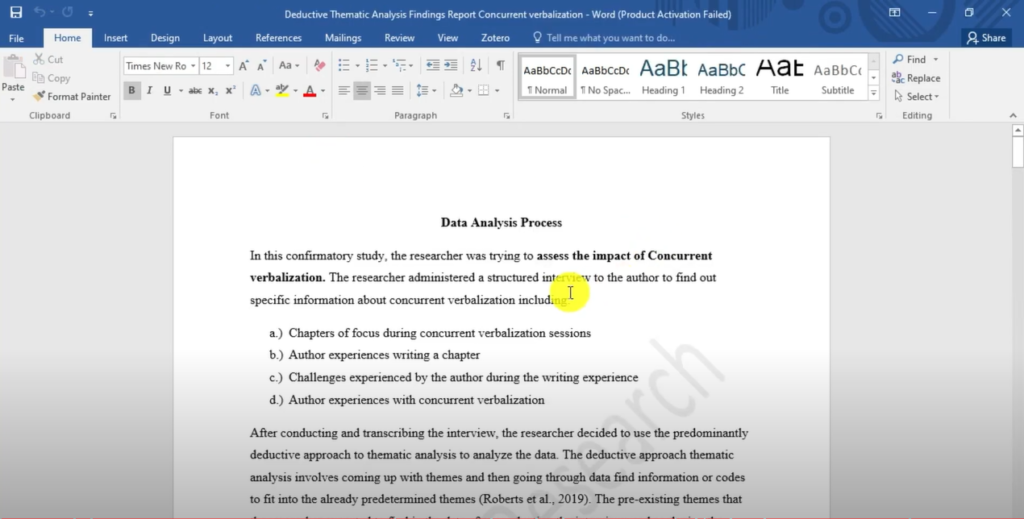
A Section of the Findings Report
Basically, the findings report describes data analysis process and also includes tables, describes themes and the subthemes and provides the participants excerpts.
There are these tables, which I exported from Nvivo.
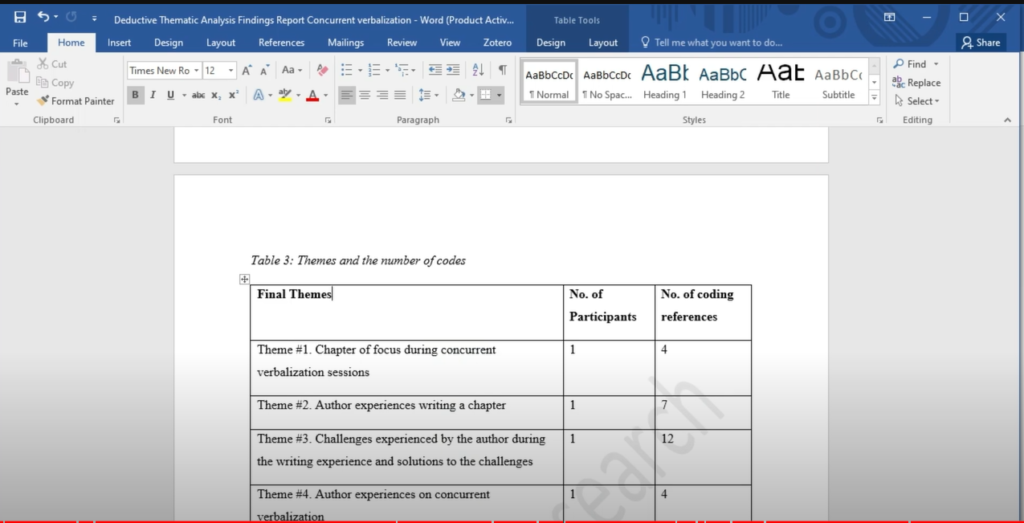
A Sample Table in a Report
You can also watch my video on visualization, where you’ll see how I made all the different visuals.9 Ways to Visualize in Nvivo
We also have mind maps in the findings report.
And that is the report. To access the complete report here is a linkInductive and Deductive Thematic Analysis Resources
